

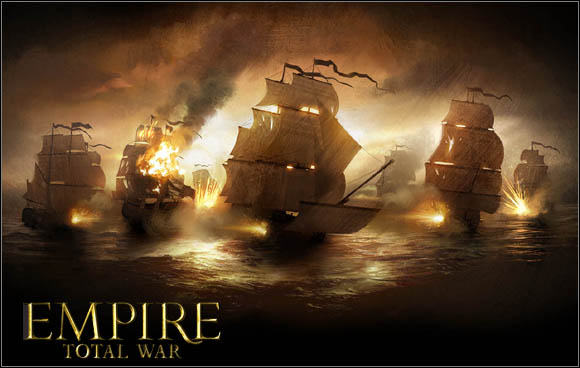
I would like to present a Empire: Total War guide. This game was created by the Creative Assembly Studio and was published by SEGA.
This text is written mainly for novice players who are learning basic rules of the game. You will find here a variety of tips for playing all kinds of battles, the game mechanics and behavior on the campaign map. In addition, in this guide you can find precise descriptions of the basic units (which can be found in Empire) and tips for all of the campaigns. The guide also includes a complete walkthrough for the American "Road to Independence".
The guide was created after releasing a patch from 10.03.2009. Informations about the size of contingents was devised by setting the size of units at the Ultra (see the graphic settings in the game).
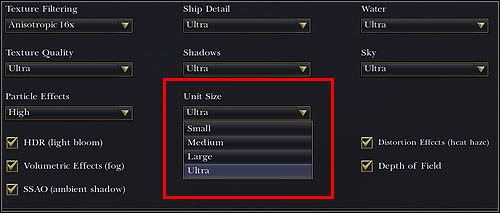
I would like to thank the players who have published many of very important ideas in the special Total War thread on the GRY-OnLine forum site. Without observations and opinions of people such as Alex, Attyla, bone_man, dasintra, Diplo, Drackula, Glob3r, peners, szlawq and cyanobacteria, this guide would be much shorter and poorer. In addition, the process of creating it would be much longer. In particular, I would like to thank a user with a grateful nickname: Pejotl. Without his aid, it would be impossible for me to learn such many things about Marat Confederation and its army. Once again, great thanks!
I hope that the guide will answer all your questions. Also, I would like to wish you a pleasant read and a lot of success in the eighteenth-century world of Empire: Total War!
Maciej "Sandro" Jalowiec
Translated by: Jakub Kuchnio
Infantry in the Empire is most important of all land units. Basically, we can divide it into two types - smaller and larger.
Smaller is when in a one regiment is 80 people (for example Austrian Pandours or American Rangers). In larger units we have 160 to 200 men - depends on the nation. The most popular representative of this type of troops is Line Infantry.
Firearm Infantry units are most popular and most important. At the beginning try to set them parallel to the line of your troops. As a matter of fact all of the soldiers will be at the same distance from the enemy. With many contingents, you will notice that the line of soldiers is quite long. Please note, that placing one regiment next to another will increase morale level of your people (they are happy that they are near their allies, in addition both flanks are secured).
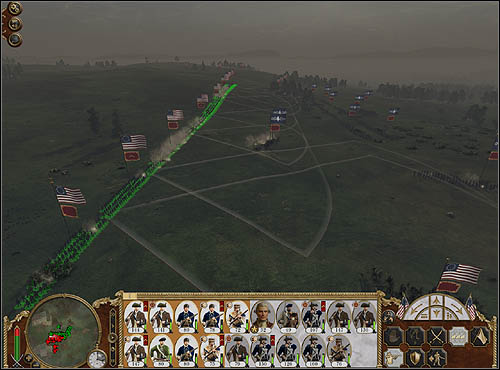
Group your regiments. Sometimes in the middle of the line is good to have 2 or even 3 regiments. On the wings you can keep them loosely or just group them in pairs. This will be very important when the fight will be close to the end.

Go very slowly and wisely in the direction of the enemy infantry. The range of your units is gently marked on the battlefield. When your people will be in the shooting range, stop them. Infantry will start the fire.
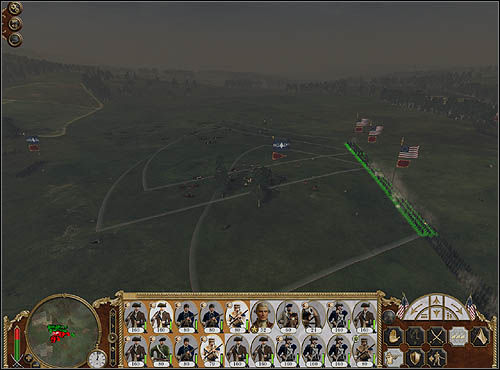 Different units have different shooting range.
Different units have different shooting range.Note that at the very beginning of the game, infantry is wasting its potential - just soldiers from the first line are shooting (and sometimes a few people from the second one). To increase the effectiveness of your regiments, quickly invent the technology called Fire by Rank, and form 3 lines from your troops. As a matter of fact all soldiers in regiment will be shooting at the enemy (the first line will fire and crouch to let the rest of the soldiers to fight).
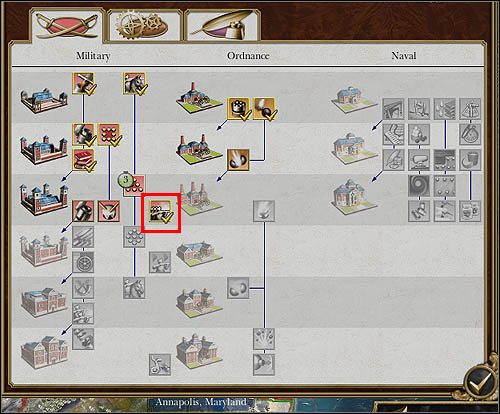 Fire by Rank is a very important technology. Try to invent it as fast as you can.
Fire by Rank is a very important technology. Try to invent it as fast as you can.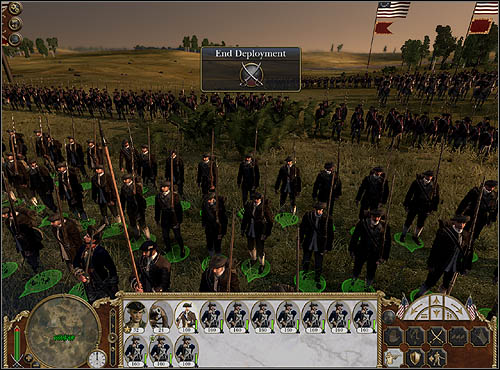 Soldiers in one regiment formed in 3-line formation.
Soldiers in one regiment formed in 3-line formation.If you will find that the opponent is using cavalry in the battle, there is a big risk that he will use it to attack you from the flank. Please remember to put regiments with bayonets on the wings (they must be able to form a square formation - this technology you have to invent as fast as possible). Soldiers with bayonets in square formation are pretty good with the cavalry. At the beginning of the game you can use pikemen and deploy them on the wings.
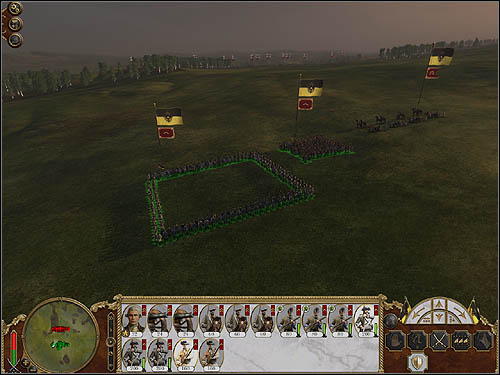 On the left we can see square formation of line infantry, on the right square formation of pikemen.
On the left we can see square formation of line infantry, on the right square formation of pikemen.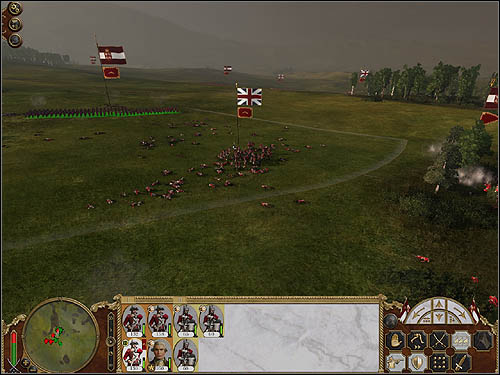 Square formation can be very useful when you will get surrounded by the enemy musketeers.
Square formation can be very useful when you will get surrounded by the enemy musketeers.
There is a big risk that the enemy - seeing that he cannot deal with you with muskets - will run to you and start fighting on bayonets. And the battle is changing its character and begins to look like a medieval battles from Medieval II. You can either engage your units that have not been attacked to melee combat or pull them back to the appropriate distance and shoot.
Sometimes you will be forced to use bayonets in combat. Always try to attack the enemy with more units than he has (you can even send two regiments for one hostile group).
 Austrian infantry attacked by the enemy units. The rest of the troops are coming with aid.
Austrian infantry attacked by the enemy units. The rest of the troops are coming with aid.Is good to use bayonets when attacking artillery too. I will not recommend you a frontal attack (your soldiers will be massacred by the cannister missiles). Try to run up to the enemy cannons from the flank or from the back. Even when you will have 80 soldiers in the regiment you should be able to defeat artillerists (because they are in much smaller groups).
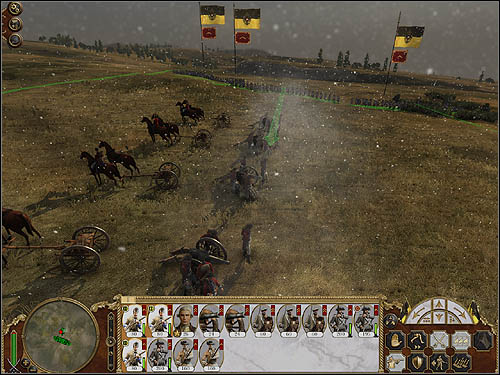
Bayonets may be also useful when your opponent is hiding behind some low walls. Its obvious that the musket fire is completely useless in that case. You can surround enemy soldiers or run up to them, jump over the wall kill them with knives. The decision should depended on the type of your forces and their combat experience.
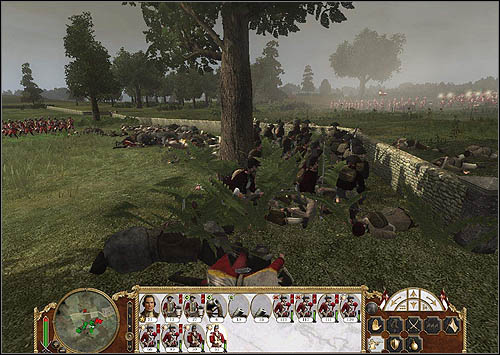
I do not recommend hiding your army behind the walls, especially when you have Fire by Rank technology. While hiding, you protect your people from the opponents bullets, but at the same time you're reducing strength of your firepower.
The more time you're spending in the game, the more things you're learning about your units. If you are aware that the units in the hostile army have better firepower than yours, then attack them with bayonets (so they wouldn't be able to take advantage of their strength).
When you notice that you are gaining an advantage over the enemy, order your regiments to attack hostile units from the flanks. As a matter of fact, you will create a semicircle around the enemy soldiers and the firepower of your units will be even more effective. Look at the picture below: the conclusion in this situation is almost foregone.
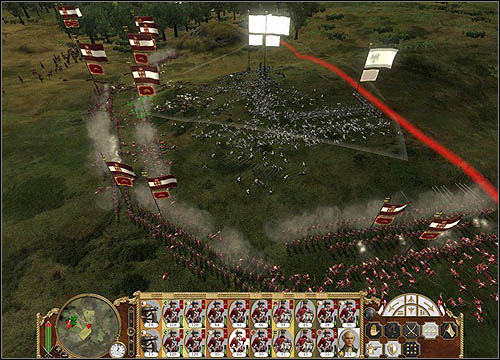
Make sure that part of one regiment is not standing in front of the next one (they can accidentally shoot themselves). It's possible that the opponent (in the situation shown in the picture above) will try to run away. Shoot deserters in the back.
There are some infantry units with a very unique abilities. These includes Grenadiers, Light Infantry, Jeagers, etc.
Grenades - Grenadiers are equipped with explosives which are very effective in the combat. There is only one condition - the opponent cannot move. Throwing grenades takes couple of seconds and, in addition, charges need some time to explode. Use it when your opponent is busy (for example with reloading a weapons). One of the best targets for Grenadiers are large regiments of musketeers. They usually move in a very tight formation, so grenades may hurt many soldiers at a time. The same applies to artillery - not only that it is not very mobile, but also explosions can completely destroy the enemy cannons.
Please note that the range of grenades is much shorter than the range of Grenadiers weapons. So you have to have a moment to run close to the enemy. It also means that the formation of your troops will be destroyed for a moment.
Stakes - when your opponent has a plenty of horsemen units is almost certain that he will try to charge. Sharpened stakes, deployed by the light infantry (for example) will calm down his enthusiasm, and reduce moving abilities of his cavalry. Palisade is a defensive structure, so if you are going to run up to your enemy and fight then there is no sense of making it (it takes a bit of time that can be spend on other, more effective actions). As a substitute, I recommend square formation and bayonets.
Light Infantry Behavior - when playing with light infantry, you can either keep them in tight or loose formation. In the second one, your troops are more likely to survive when the enemy artillery is shooting. However, keep in mind that after that kind of run your regiments will need couple of seconds to regroup.
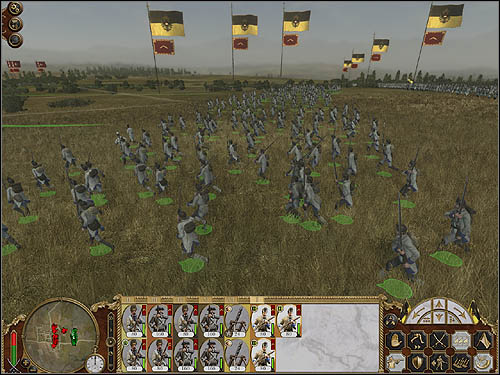
Many units have a special ability to hide in the woods, high grass, etc. Among these troops is light infantry and units that can be used to disturb and harass the enemy army, such as Rangers, Courers de Bois, and Siberian Hunters.
These troops can be deployed on the battlefield in several ways. You can put them before the main army and wait for the enemy. Attack suddenly and go back to your main regiments - that strategy may confuse your enemy.
There is also a second strategy: put your main army in the back and deploy hiding troops on the flanks. This situation is presented on the picture below. Turkish forces are standing in one line and waiting for the enemy. Bashi-Bazouks armed with sabers are waiting for the enemy infantry..
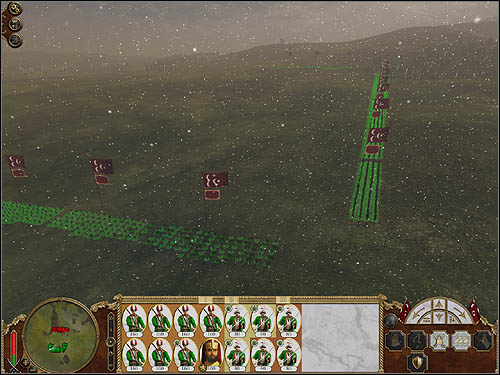
In the battle sometimes you have to use rabble (there are plenty of them but they're quite bad in fighting), for example: Musellims or Firelock Armed Populace. Note that units that do not have very good statistics can be used to perform some minor tasks.
The first one is to eliminate hostile artillery. Cannons are operated by a small number of artillerists, so even a large number of peasants armed with pitchforks can handle then. As you know, at the near Raclawice Kosciuszko used such a rubble to eliminate the Russian artillery.
Another task for canaille may be to stop the enemy infantry for the short period of time. The group of peasants can fight and delay hostile units. That time can be spent on deploying your artillery, or sticking stakes against enemy cavalry, etc.
Eventually, these forces can be used as a support for the regular troops of your army. Try not to do it too often, because rabble will be always the weaker point in your army. When the enemy is fighting with bayonets the mob should be fighting too (mainly because of their number), but do not expect sensations here.
When you notice that the opponent is gaining a significant advantage on the battlefield, I suggest quickly end the fight and withdraw your troops. When the battle will be completed, your units will have a chance to move to another location on the campaign map and regroup (under condition that they were not retreating earlier in the same turn).
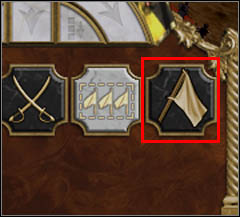
Cavalry can be used to perform several tasks on the battlefield. Although you can manage without them, their support is often priceless.
Is good to have cavalry with good Charge Bonus.
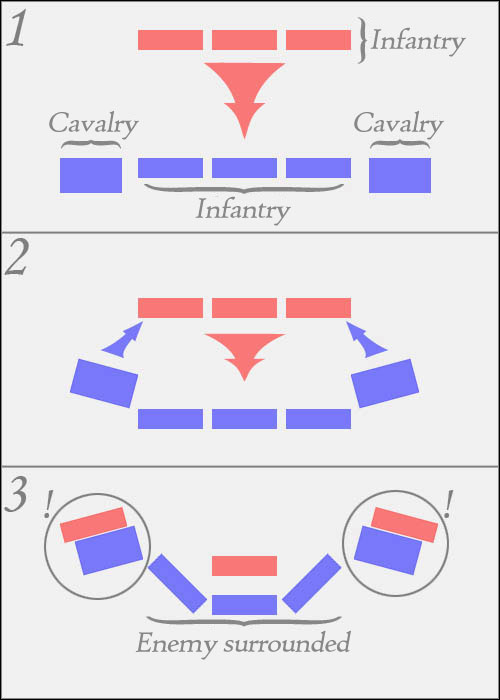 Indian cavalry have charge bonus on a quite high level
Indian cavalry have charge bonus on a quite high level
Most of the cavalry units have only 60 people in one regiment. As a matter of fact, I propose to charge only small regiments of infantry (60-100 people). In the case of larger groups your cavalry can be literally mired down by the bodies of dead soldiers and because it has very low defense statistics it will be quickly killed with bayonets.
Slightly different situation is when the enemy is busy with shooting with muskets. Then you can try to attack them from the back when they are reloading their weapons. Before the enemy will realize what really happened, the majority of your cavalry will have time to retreat and prepare for the next charge.
Try to avoid charging from the front. Before your horses will reach the enemy, the opponent will kill many of them with muskets. The rest of cavalry will stick on bayonets.
It is closely connected to charging. Note that your opponent is usually setting his regiments so they can form a line. If you read the previous chapter about the infantry, you should know that you should do the same, keeping cavalry the wings. With the cavalry you can attack enemy units (that are deployed on the flanks) from the flank or from the back. As a matter of fact, you will shorten his line allowing your troops to surround his soldiers.
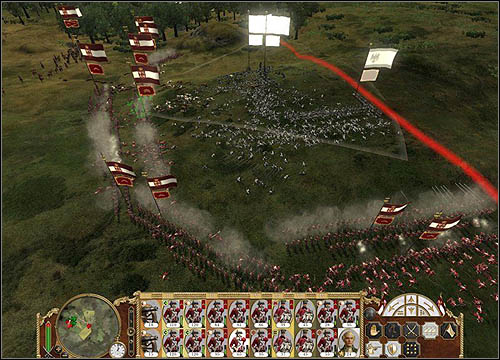

On the diagram above, exclamation marks and circles means that the cavalry is fighting with infantry. Depending on the size of the regiments the results of these clashes may be different. If there will be 80 people of enemy infantry and you will attack them with 60 horses, you probably force them to flee. But if the enemy will have 120-200 troops on the wings you are be able only to damage his regiments. Then you can pull them back and allow the infantry to finish the job (from now on they will be over-represented). You can use cavalry to charge from behind.
If you can use firearm cavalry, such as Deli Horsemen or Light Dragoons, you can quickly ride up to the enemy, fire, and then quickly pull back your horses. I recommend this solution if you cannot afford a cavalry with a good charge bonus. Cavalry fire is often less effective than charging, but the other hand you can avoid tolls associated with the melee combat.
Moreover, in the case of dragoons you should remember that these soldiers can always get of their horses and fight. These types of units can be a great supplement to your main army, putting enemy troops in crossfire.
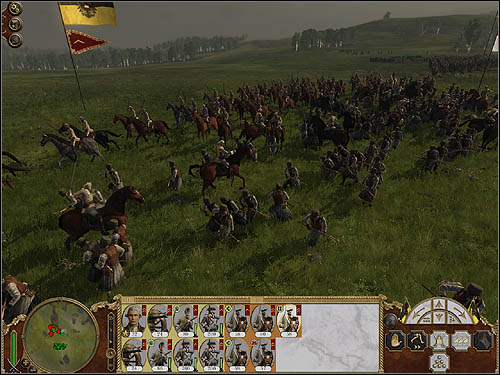 Line Infantry shoots with muskets, while Dragoons are attacking enemies from behind, shooting from the forest
Line Infantry shoots with muskets, while Dragoons are attacking enemies from behind, shooting from the forest
The first thing is that artillery can fear your soldiers. So destroy it as fast as possible. If you have cavalry, attack hostile cannons from the back or flank (this will limit the toll in your units). Horses are fast and they will quickly eliminate enemy artillerists (the are not many of them so they won't kill too much cavalry units). In fact, in most cases your opponent will leave his artillery without any defense so even light cavalry can kill crews of the cannons.
When you will destroy the morale of the whole enemy army, you will have a choice - end the battle or continue it and try to eliminate as many fleeing soldiers as you can. I always recommend the second option (in the first situation hostile army will be still on the campaign map and you'll have to fight with it once again).
Fleeing infantry is quite fast - it is hard for your units to catch up with them. Because of that, it is good to use cavalry to take them down.

Apart from improvements such as "Carbines" (allows to train firearm cavalry), it is worth noting that there are additional technologies, such as Wedge and Diamond.
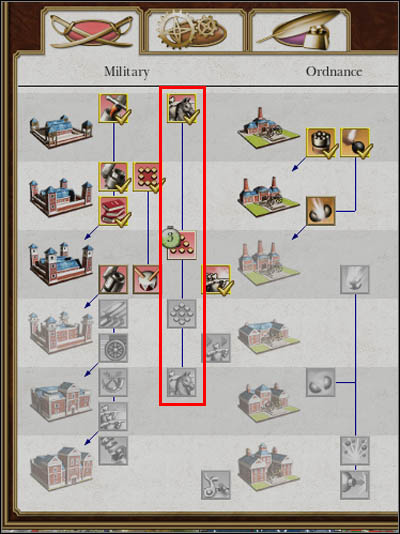 Cavalry improvements
Cavalry improvements
Personally, I found Wedge very useful. It can be used to break-through wide column of hostile regiments. However you should be very careful here, because horses surrounded by infantry can be easily killed with bayonets. When you have to deal with poorly trained troops (mob) or fatigued and discouraged soldiers (for example, because of the death of the commander), you can try to charge using a Wedge.

Diamond have a rather modest military usage. This is useful mainly for the maneuvers. Cavalry formed in diamond formation reacts slightly faster to orders and changes direction much quicker, so I recommend turn off the diamond and form wedge formation just before the fight.
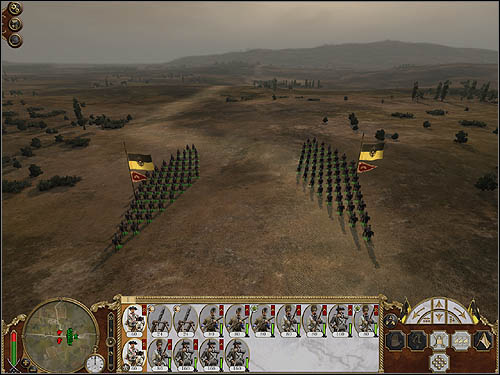
Artillery, more than ever before, have been very important on the eighteenth-century battlefields . Always try to have it in your army (2 or even 3 units).
The destruction of buildings occupied by the enemy troops can be very effective - you can kill many hostile units without any looses in your army. Not always, however, it depends on accuracy of your cannons.
Try, as soon as possible, to change Sakers and Demi-Cannons to artillery that can move on the battlefield using a horse-drown cart. With mobile artillery, it is possible to drive up to the occupied building. And the closer you are to the target, the more accurate are your shots.
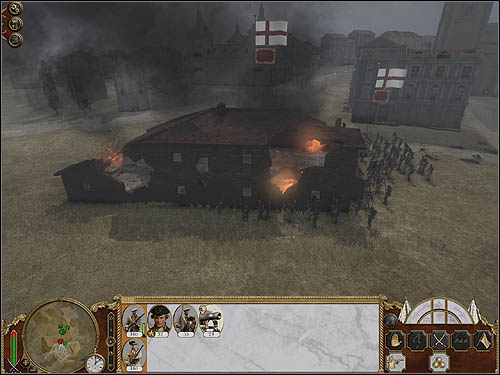
After inventing the technology called Cannister Shot some of your cannons will be able to use ammunition that is perfect to eliminate the enemy infantry. When the opponent is attacking, load the Cannister Shots. However the missile range will be shorter now, but you can kill up to a dozen enemy soldiers for just one shot.
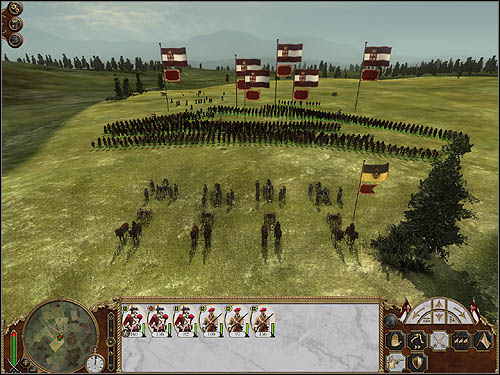 If the Austrian artillerists would began to fire Cannister Shot on Poles, then toll in Polish army would be substantial.
If the Austrian artillerists would began to fire Cannister Shot on Poles, then toll in Polish army would be substantial. Some units, such as all types of Howitzers, Mortars, and rocket troops (Troop Rocket, Rocket Band) have a powerful range. This means that before the battle, artillery can fire at the enemy for a long time. At a long range it is difficult to have a good accuracy, so cannot eliminate to many enemy soldiers. However you can fear them by a ordinary (not accurate) bombardment.
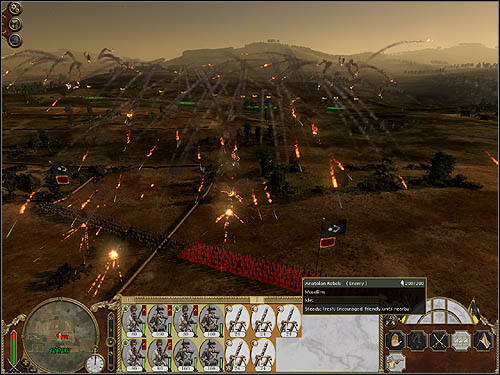 Before the enemy will come to you his willingness to fight will be rather questionable.
Before the enemy will come to you his willingness to fight will be rather questionable.
For this type of bombardment you can use ammunition that is designed to be effective against infantry such as Explosive Shells, Carcass Shot, Quicklime Shells and Shrapnel Shot.
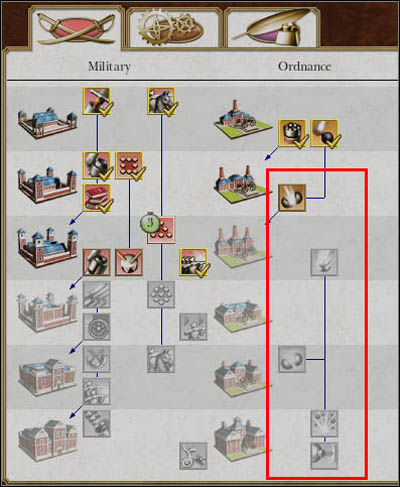
Sometimes, artillery is left without any protection - all infantry and cavalry is focused on the fight, and cannons are left alone. I recommend to keep 1 or 2 infantry units armed with bayonets near your artillery. It is in case your opponent will come up with an idea to attack your artillerists with his cavalry. In the case of the horsemen attack it makes no sense to use Cannister Shots - you do not have time to turn cannons and load them with proper ammunition.
For some types of artillery there is no difference from which position it is shooting (for example Puckle guns). Sometimes, however, your army can refuse to fire. This can happen when some obstacles (nearby trees, etc.) are between your troops and the enemy army (this is often a problem for the rocket troops). You can help your artillery by deploying it on a hill.
Sieges can be simply divided into two types. The first one is when the opponent do not have siege walls. While the second refers to the situation directly opposite - the enemy is sitting in his fortress. Depending on the conditions the attacker strategy must be different.
Sieges are very similar to land battles - use line astern formation and try to surround your opponents. However, there are some significant differences and it is necessary to mention about them here. First of all, notice that the enemy is keeping some of his infantry in buildings. If you have many good cannons, you can simply destroy these buildings and bury hostile soldiers in the ruins. You can also attack fortress with your troops. Depending on the level of difficulty the number of units required to exterminate all opponents will change. For the average level of difficulty is recommended ratio of 3:2 (3 is for you of course).
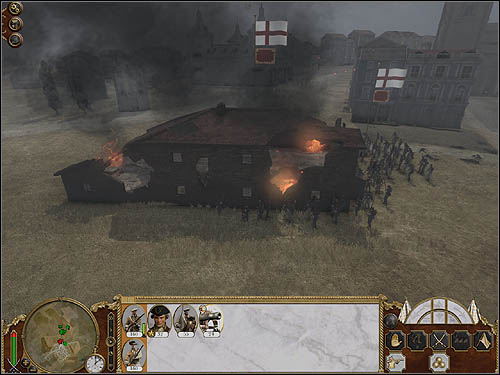 Artillery can help you to kill many enemy infantry troops without any looses
Artillery can help you to kill many enemy infantry troops without any looses
Keep in mind that your people will suffer because of the mines. Fortunately, they are always in small numbers, so the losses will be rather moderate. Be careful with the cavalry. Artificial Intelligence likes to deploy stakes to stop your horses.
In 99% of all cases opponent will mulch artillery with sand bags. Thanks to them, enemy artillerists are almost completely secured from musket fire. So I recommend to jump over these bags and attack with bayonets or charge with cavalry from the back - artillery is almost unsecured from the back.
Generally, I do not recommend to attack fortified forts only by yourself. Intelligence of units is on a very poor level and soldiers mistakes can result in your defeat. Even, when you are over-represented or when you have technological advantage.
If you want to lead the battle only by yourself, you have to make sure that you have appropriate artillery. It is important to have a possibility to move your cannons using the horse chariots. With so-called fixed artillery, there can be a problem with cannons range: not always, you can deploy it close enough to successfully attack siege walls. With mobile artillery you don't have this problem. Two regiments of 12-pounds howitzers is enough to destroy siege walls quite fast.
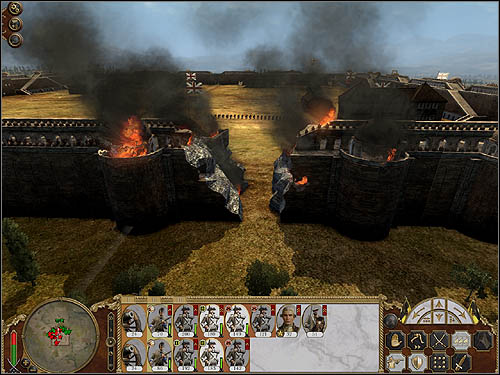
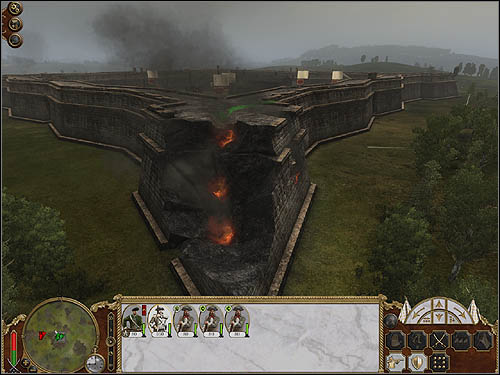 If you have time, you can destroy that parts of walls where enemy cannons are deployed
If you have time, you can destroy that parts of walls where enemy cannons are deployed
I recommend to deploy artillery and infantry in line astern formation (a few dozen meters from the enemy fortifications). When you will start to shoot the walls, the enemy will come up to you to start fight. Then the battle immediately turns into a simple land battle in which fire of muskets and the Fire by Rank ability are most important.
After making some damages in the wall, you can try to get inside. If the opponent wants to come out, surround the hole in the wall and shoot his troops. Enemy regiments will not have enough time to reorganize and answer. This will result in serious looses in their lines.
If the opponent does not want to go out you will have to go inside the fortress. The best way is to do it quickly, because the enemy has cannons on the walls - the longer you standing outside the walls the more of your troops will be killed.
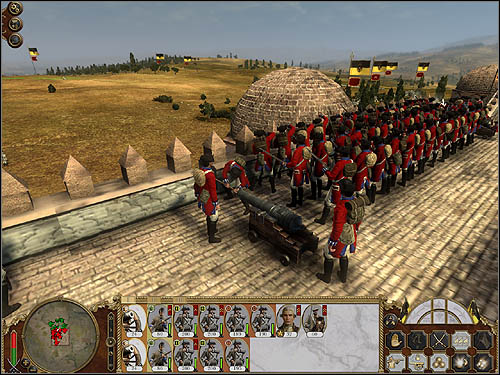
The first thing you have to do after entering the fort is to go to the center of the square and stay there for a while. The timer will be displayed in the right upper corner.
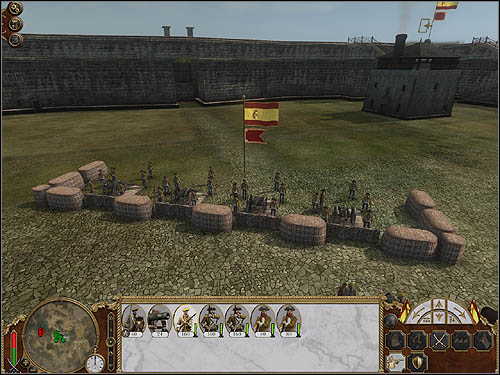
To be honest, many things can happen during that kind of fight. You cannot forget about bayonets, which will be useful in the fight against a general regiment (in most cases it standing in the center of the fortress).
It's possible that you will have to shoot enemy infantry which is going down from the walls to defend the square. In this case, you can either fight with bayonets (hoping that it will be disastrous for the opponent).
If you have the cavalry, then try to find troops that are coming out from the side gates . Attack any type of cannons and smaller groups of infantry that are located outside the fort. There is no sense in going inside with cavalry (firstly - there is not too much space inside to charge effectively, and secondly - horsemen intelligence does not allow them to quickly and smoothly pass through the gate).
If you don't have any cannons or you want to kill as many opponents as you can, you must climb on the walls using ropes. Come near siege walls and order your people to climb.
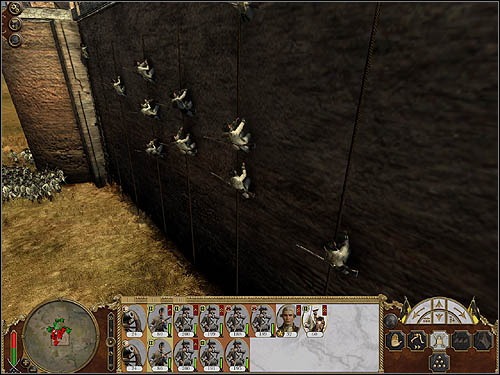
In this case, losses are inevitable due to the hostile artillery and soldiers waiting on the wall. When you are on top pitched melee combat will start so it is important to equip your people with high-quality bayonets. It is also a good idea to assault walls with infantry specialized in close combat, for example Cemaat Janissaries.
In fact, there is no difference where you will enter the walls. Even if you choose unsecured piece of fortifications, enemy soldiers will have enough time to reach you.
As with the attackers: every battle can be different. It depends on whether defended city is surrounded by siege walls or not.
When you don't have walls, siege is very similar to a simple land battle. Most of fights takes place on ground, just next to the buildings.
First of all, forget about deploying your troops in the buildings. In most cases, opponent will have artillery won't hesitate to simply destroy your houses. It is better to send infantry into the battlefield.
The second important issue is to create provisional fortifications and traps. If you have a line infantry, try to make some trenches (your soldiers will be a difficult target for the enemy).
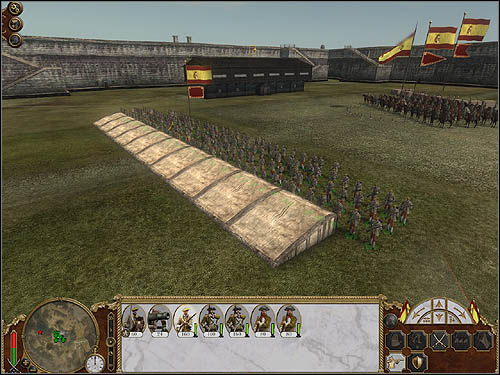 You can make provisional fortifications in normal battles too. There is only one condition: your army must be attacked after two turns of standing in one place.
You can make provisional fortifications in normal battles too. There is only one condition: your army must be attacked after two turns of standing in one place.
If your enemy have cavalry, you can deploy some stakes. You won't be able to stop them (they can see obstacles from a long distance), but it certainly you will limit horsemen maneuvering abilities.
If you have the opportunity, deploy some land mines on the battlefield. The best way is to arrange them in front of your infantry at the point where their shooting range is starting - you will get a pretty effective combinations of explosions and musket fire.
Your opponent is attacking so there is no point in changing positions of your artillery. When cannons will be deployed, you can create a provisional wall as a protection against musket fire. Cannons prepared in that way can crush your enemies with Cannister Shots. However, beware of your unsecured back - this is an excellent target for enemy cavalry.

In many cases, initial arrangement of your troops is very relevant (they standing close to the enemy). I suggest, do not change it at the beginning. You can always do it later.
If the opponent has a lot of cannons, he will attempt to destroy the gates and siege walls. In this case, order your soldiers to go down to the ground and defend holes in fortifications. Welcome your enemy with I lot of bullets.
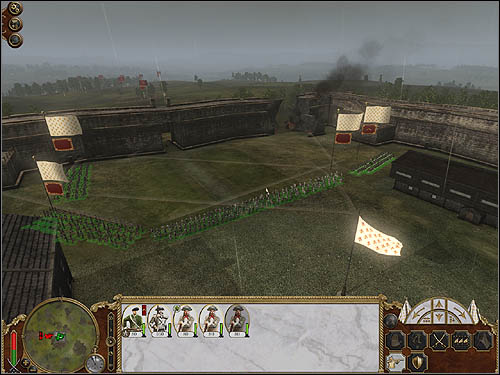
But mostly, enemy will try to climb on walls with ropes. In this case, deploy your troops as it is shown below.
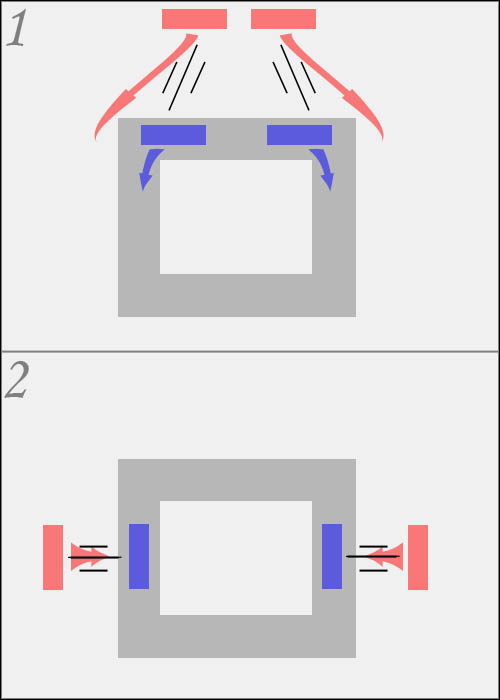
Opponent will come close to the wall and then he will try to attack from both flanks too. You can fire with muskets (and cannons mounted on the wall) on the front (schedule, part 1) and on the sides (part 2).
On the walls soldiers will be fighting in close combat. Tell them to use bayonets and start to exterminate your enemies. Do not click on enemy troops, because your people will come down from the wall and start fighting with opponent that are on the other side of your fortress. Just order them to move near the place where enemies are expected to appear.
Try to adapt your forces to the enemy forces. If you see that your opponent is attacking you with a mob, fight with mob too. It is about making the best use of your army. Try to avoid a situation when enemy will capture those parts of the walls, which are located on the gates - he will take control over them.
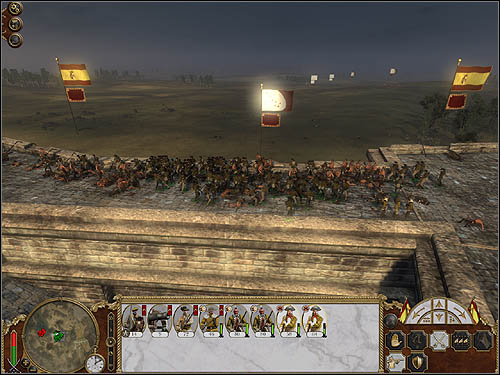 Weak in close combat Cherokee Bowmen fights with Firelock Armed Citizenry
Weak in close combat Cherokee Bowmen fights with Firelock Armed Citizenry
If you have cavalry, charge immediately when the enemy infantry will enter the square. You can also try to leave the fort and kill the enemy Brigadier (it is better not to risk a fight with general regiment). In most cases Brigadier is in infantry, so he should be eliminated from the game with one good charge. Where is brigadier? You can check it in the army panel, which appears just before the siege.
If you have artillery in the fort, you may naturally decide to fire at enemy units, but keep in mind that the effectiveness of the fire is at least questionable. Also beware of the infantry cannons - they tend to shoot at the walls of your fort. Howitzers and mortars are performing slightly better with the firing at the incoming enemies.
Note that most of the ships available in the game have a word "line" in their name. This means that they have to move in Line Astern Formation during the battle. Ships are sailing one after another (as it is shown in the picture below).
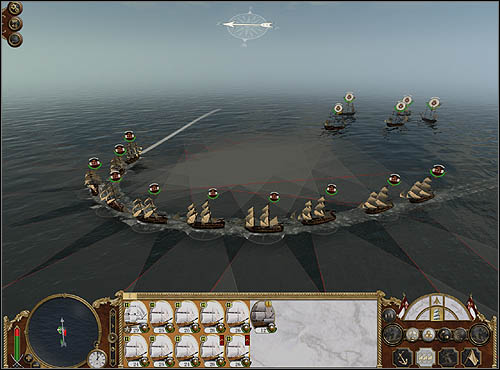 Computer opponent will sometimes use the line astern formation too
Computer opponent will sometimes use the line astern formation too
To be able to move effectively in that formation, set your ships in one line before the battle (you can use formation panel shown in the picture below), and then select and group them (Ctrl + 1). Since that time, ships will sail in the line astern formation. There is a risk that it will broken, for example if one of the ships will be sunken, or when you start giving your orders too fast.
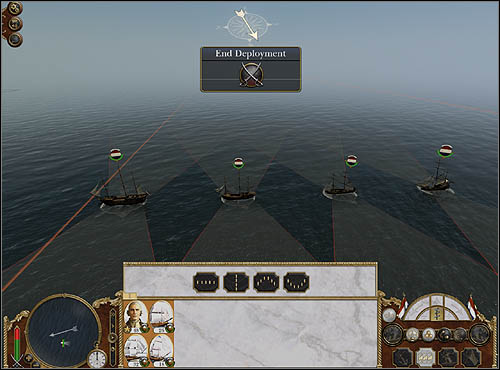
Why is good to use line astern formation? Note that this arrangement is almost perfect - only stern of the last ship is unsecured. You can sail along enemy fleet fire at him from your cannons.
You can either order your ships to sail near enemy and fire at will, or give them an order to attack a specific unit. If the enemy is also using a line astern formation, I recommend to destroy the last ship - your units will simply fire at its stern. That kind of action can result in two ways: you will sink this ship or force him to turn (that will break opponents formation).
I do not recommend to use side volleys. First of all, they require you to be very precise, and secondly they cannot be launched if you're not operating each ship individual - and such action could easily break the line astern formation.
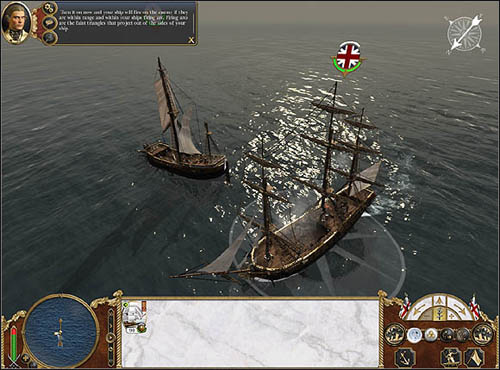 Crossing the T - sail near enemy bow or stern and launch volley at the enemy.
Crossing the T - sail near enemy bow or stern and launch volley at the enemy.
The so-called Crossing the T is one of the best maneuvers that can be performed in the game. Look at the picture above. As you can see, you must turn your side of the ship to the bow or to the stern of the hostile battleship. In this situation, two vessels seen from a bird's eye will form a letter "T" in which your ship serves as a line on the top.
Why it is good to use this maneuver? Both the bow and the stern are unsecured - the number of cannons in these areas are very low. When you use Crossing the T your enemy is unable to answer with fire for a short period of time.
Do not use side volleys when doing Crossing the T - you will avoid losing missiles. It is better to order a simple attack which can result in better accuracy and increased firepower.
Sometimes it may happen that formation of both armies will be broken. Then the battle will become into a series of isolated clashes between individual ships. You have to be perceptive and look for any opportunity to damage enemy hulls.
During this type of fights you can use as many side volleys as you want. By clicking the appropriate buttons in the right lower corner of the screen, you can order to load cannons on the left or on the right side of the ship.

During that time your ship cannot shoot. With loaded cannons fire is more focused and precise.
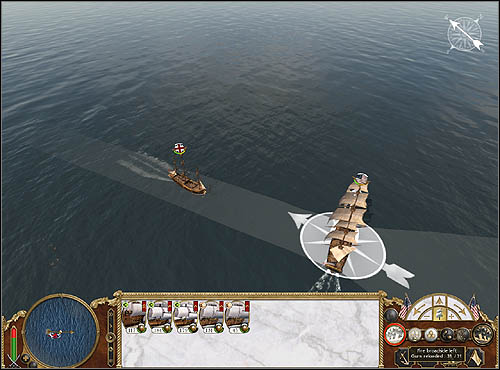
Whack with volley can severely damage the enemy ship. However, you should be careful with it. When vessels are close to each other missiles have a strange tendency to miss their target. Especially with larger units where cannons are placed high above the deck of the smaller ships.
Generally, I do not recommend this trick. Standard fire can be precise too, firepower is similar and it has much greater firing arc.
Depending on what you want to do with the opponent, there are several answers for the question from the title of this sub chapter.
If you want your opponent to flee you must do Crossing the T and fire at the enemy stern.
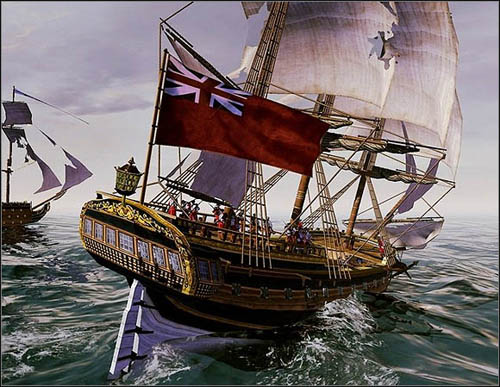
On the stern there are cabins of captain and senior level officers. As with land battles: killing commanders will drastically lower privates morale. The crew without officers will be try to run away from your ships. Use normal ammunition when attacking the stern.
You can also try to damage enemy rigging. Firing chain shots from a comfortable position to attack the stern will allow you to destroy number of masts and sails in a very short time.
Cannons are deployed on both sides of the ship. If you are planning to sink enemy vessel or simply destroy his arsenal, place your ship in line with the enemy unit and start the bombardment.
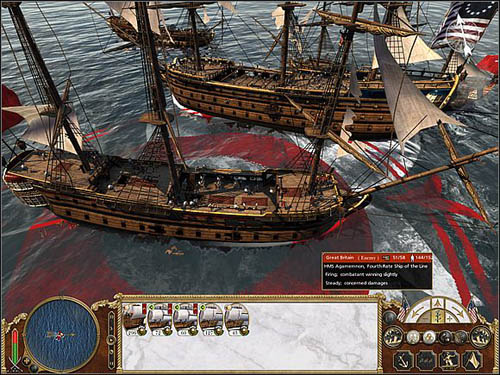
Destruction of sides and cannons can be very time consuming. In a fight one on one (with similar units) toll may be significant. If you want to destroy sides, use normal ammunition.
After damaging side of the enemy ship, verify if the vessel is not listing on one side. If you will notice that, it will mean that water is pouring slowly to the opponent ship bunker. In this case, you can either complete the work and finish him off or just wait a few minutes - the vessel will sink.
Doing Crossing the T in front of the enemy bow is a very good action. First of all, the front side of the ship is (in most cases) poorly armed - couple of cannons and some musketeers. The risk of serious losses in your crew is not very high.
Bombardment of the bow, will not result in serious damages of the enemy hull, but it will create very good possibility for the destruction of the enemy rigging. Note that the chain shots fired towards the bow (in line with the ship) can break a few sails and masts. More informations about the destruction of rigging is written below.
Use chain shots to destroy masts and sails of the enemy ship. Attack in this way especially when your opponent is sailing with the wind and has set all the sails.
You can check the condition of the rigging by looking on a white mark which is located on the ship icon. By destroying mats and sails you will cause that the enemy will not be able to move. Vessel in that condition is a very easy target (even for the weaker units). When the hostile ship will be immobilized shoot at his stern.
There is a chance that the enemy with partially destroyed rigging will try to run away.
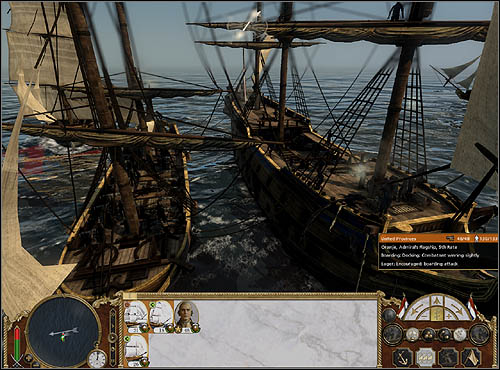 You can set fire to the enemy sail using rocket ships. Remember that burning vessels can explode at any time.
You can set fire to the enemy sail using rocket ships. Remember that burning vessels can explode at any time.You can demolish enemy lines with grape shots. These are small balls, which - like bullets from muskets - can kill many hostile soldiers in one moment. Actually, they have one big disadvantage: very low accuracy. Use it especially when you want to intercept the enemy vessel.
After each bombardment check how many people left on the enemy ship. When you will notice that his crew is rather sparse, you can start boarding it (you can't kill all enemy soldiers with grape shots).
Moment of boarding must be wisely chosen. The most important thing is that you have to have more people than your enemy. On the other hand, when you start it too late your opponent can simply run away (because of the panic caused by death of the crew).
I hope that your shots will always hit the weak points of the enemy ships. As you may know, sometimes vessels can be carrying barrels filled with gunpowder. When you hit that kind of barrel , fire can start. As a matter of fact enemy unit will be ineffective and may sink.
The best is to hit powder stock-room directly. Hostile vessel will, literally, blow up and will be unable to fight anymore.
If you want to take the enemy ship, you have to check how many people he has on the board. Compare that number with your, and decide. If number of your soldier outnumber his, then you can start boarding operation. If not, better use grape shots first (his crew will be decimated and it will be easier to take control over that vessel).
If your opponent will try to run away, destroy his sails and mats - he will be much slower.
Your people have to throw ropes to the enemy ship. You cannot do anything at that moment (only defend yourself).

During the fight is good to check condition of the enemy vessel. Just move your cursor on the ship and the special pop-up will be shown. You can read there if the enemy is ready to surrender (if it will be true stop the boarding operation). Sometimes hostile vessels can surrender without boarding operation -later, you can simply conscript them to your fleet.
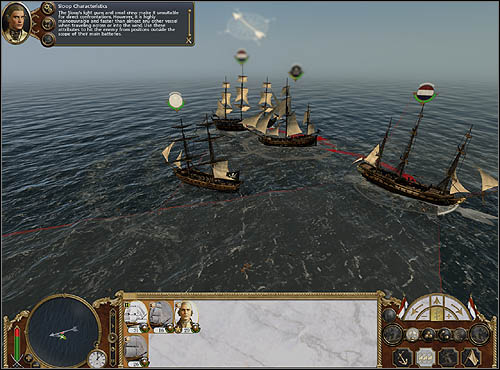 Once defeated crew will cause no problems in the future
Once defeated crew will cause no problems in the future
After the fight you can take look at some statistics. All captured units will be shown there and you can decide to conscript them to your fleet or not. If you'll choose the first option you will have to pay them. In the second case you can get some prize money for the captured vessel.
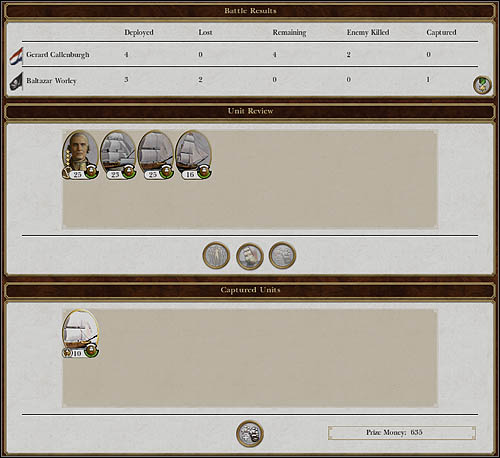
In naval battles wind is very important. You can always look at its direction in the upper section of the map (wind direction is also shown on the mini map).
 The length of pointer symbolize the strength of the wind.
The length of pointer symbolize the strength of the wind.
The game is about XVIII century wars. Most of the ships in that period were using sails (and wind of course) to move. The importance of wind was very high. Steamships are the only exception, but in most cases wind was significant.
Your units are moving with the maximum speed when they are sailing with the wind. To get the strongest effect you can order to set all the available sails.
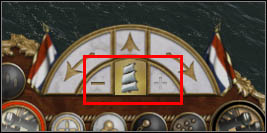
When you have headwind then the best option is to sail without any sails. Ships can move with headwind but they are extremely slow. With the wind blowing from the side you can get average speed.
The is only one conclusion: try always to sail with the wind in the battle. Ships with headwind are slow and they are easy target. Remember that one the most important attribute of the good commander is to minimize the risk.
You can gain some advantage by controlling your troops on the campaign map. First of all you must remember that armies must be close to each other. Keep them in their reaction zones marked with green lines (look at the picture below). As a matter of fact when one army will be defeated the others can come with aid very quickly.
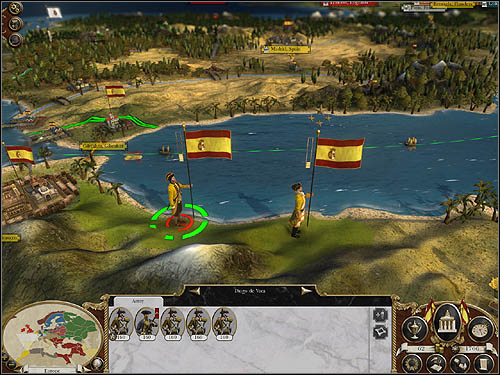
Remember to replenish your regiments after each battle. The most experienced troops can be combined (marked as red on the picture below). You can call some reinforcements to the less meritorious . As a matter of fact you will get some very good regiments and more of troops that have to gain some experience in the next battles.

There is no sense in attacking enemy harbors, factories, farm etc. The first thing is that it is better to take control over the area that can produce goods. In addition computer controlled player will get money for free (even when the are not producing or selling anything). You cannot harm them in that way then.
Remember that your army can attack trade routes too. However moving on the enemy territory is connected with the willingness to take control over some new areas. As a matter of fact, the possibilities of blocking trade routes will be extremely rare.
The same thing is with fleets. When ships are in their reaction zones (mark as green on the picture below) then they can support each other.
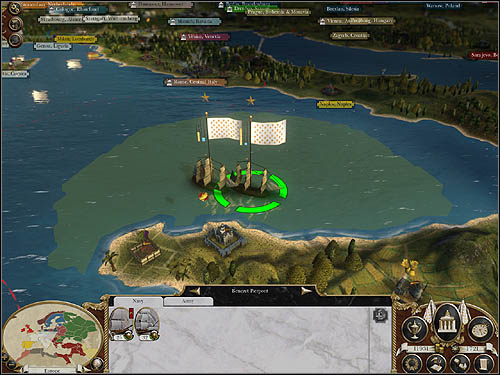
You can repair your vessels only in the harbor. Is good to do that because this can result in more experienced army (older ships will not be defeated so easily).
Sometimes your land troops can move using ships. Note, however, that you cannot let them to land at any place (they may lost their turn and won't be able to move). This situation can be prevented. If you want to attack enemy country, you can simply order your ship to enter the enemy port. After landing, soldiers will be able to move in the same turn and even attack some fortress.
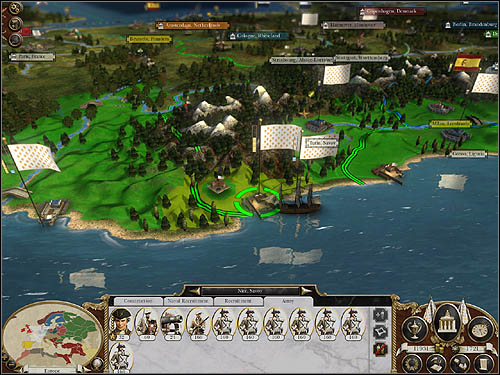
At the cost of the Brazil, West Africa, Madagascar and Philippines you can find regions that can serve you as a colonial trade zones. You can deploy your trade ships there (dau, indiaman, flueta, galleon, etc.) in special paces marked with anchor. From this moment you will be able to import some exotic goods (like ivory). Generally, the more vessels you will put in the place the more gold you will earn. But note, that the amount of money for one ship will be lower. Let me put it in this way: if you have one ship then you can earn 500 monetary units, but with two vessels the maximum amount of money will be between 501 and 999. The total amount of money that you can earn from this type of activities depends on trade agreements which you have at the moment.
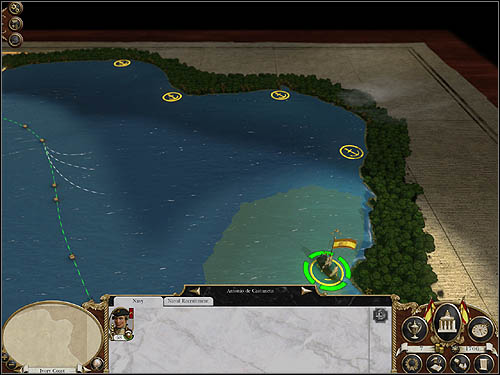
In these regions pirate fleets are very common. Always try to keep your ships near colonial trades zones or your territory. If somehow it's impossible then better prepare your troops to the fight with pirates.
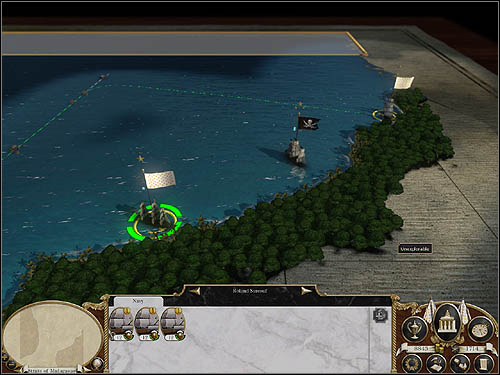
Remember that you can be a pirate too. In Empire it is possible. Just make some new ships and look for some enemy trade routes (they are marked with red lines). If there is no battleships of your opponent in this area (it is possible - for example The Ottoman Empire is trading with countries in America, but they don't have any battleships in this region) then you may try to attack. Just put your vessels on the route. Your ships will automatically assault enemy trade ships and capture all goods and gold.
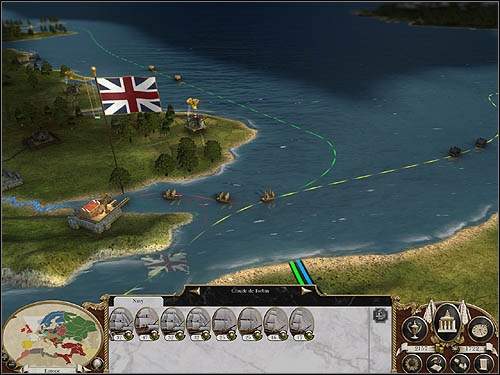
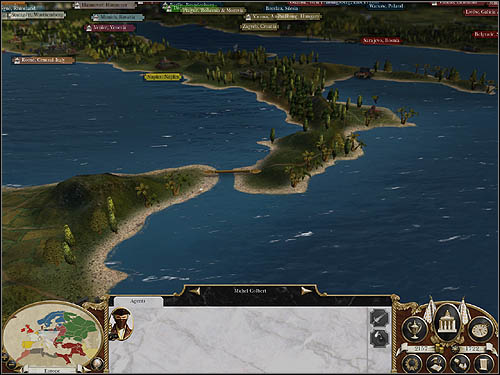 You can attack some water crossings too.
You can attack some water crossings too.
We can divide countries in Empire into two main categories - major and minor.
Major Countries:
Austria
France
Spain
Mongols Empire
Ottoman Empire
Marat Confederation
Netherlands
Prussia
Russia
The Republic of Poland
Sweden
Thirteen Colonies
Great Britain
Main attributes of these countries are:
1. extensive territory;
2. huge army;
3. powerful fleet;
4. importance in trade and international diplomacy;
5. not many troops for one province;
6. strong diplomatic connections with other countries;
7. easiness to make a peace;
8. high prestige level.
Of course situation in the game may be different. When one of the main country will loose too many territories(and it is close to collapse) it will start to look like a minor country.
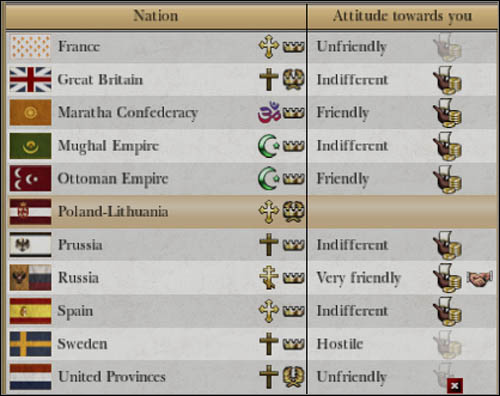
War with the one of the main countries are conducted on land and on the sea. These countries in most cases have access to the sea and some dockyards. It is pretty easy to conquer small provinces etc. The things may get more complicated near the capital city. This is the place when most of the troop are gathered.
Minor countries are all types of small kingdoms and Indian Confederation, for example: Cherokee, Bavaria, Saxony, Wrttemberg, Portugal, Georgia, Persia, etc.
Main attributes of these countries are:
1. small territory (1-2 regions);
2. not very huge army;
3. many soldiers per capita;
4. no prestige;
5. almost unable to make a peace;
6. almost at once you can take them under your patronage.
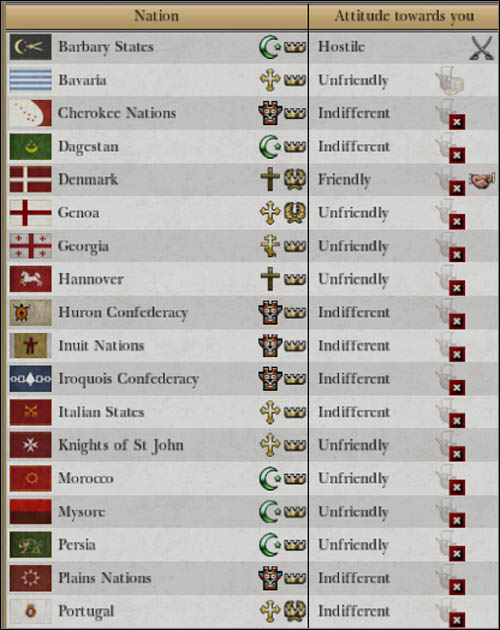
Minor countries can be a very good trade partners. They don't have huge ambitions and their army is very weak (couple of regiment to secure small territory). However their capital city is always strongly defended. Every war with that type of country will be short and very painful. Instead of war you can always try to take them under your patronage.
Nations are very similar to each other: you are ruling always with the same way (only names of the political systems are different). For example: in republic you have ministers and they are almost the same that advisors in absolute monarchy.
So if I started with politics then it is a must to say something more about it.
In Empire we can find absolute monarchy (France, Russia), constitutional monarchy (The Republic of Poland, Great Britain) and republic (Netherlands, Venice).
In every country we have a ruler. It may be a king/sultan/president - it depends on the political system. Apart from him there is also cabinet with the prime minister and four ministers (the names of these departments may different - depends on the country and system).
 In monarchies you don't have elections.
In monarchies you don't have elections.
Ministers are responsible for four departments: treasury, justice, army and navy. You can get some statistics by putting mouse cursor over the portrait. Remember that prime minister is responsible for prestige and citizen wealth, treasury minister can grant you some bonuses from taxes, etc. If you will click with right mouse button on the portrait you can get some more detail information.
Apart from minister sometimes you may find that some countries have colonies administrators. Like Netherlands which have colonies in India and South America. That's why you have two more persons in the cabinet.
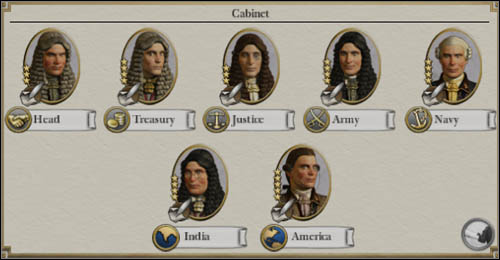
Statistics of each politician depends on his character. If you notice that one politician have a very destructive influence on the country, immediately change him. Statistics also depends on politicians experience. In most cases, younger people will have worse influence on the country than old ones.
Monarch (or president) is mostly to represent his (or her) country outside. He can make some diplomatic agreements with other countries.
Differences in political systems may result in diplomacy. Countries will be in better relations with each other with the same political system. As a matter of fact nations with the other system will be treated as a worse ones. Always you can check how your political system is influencing your relations by putting your mouse cursor over the province.
Religion is very important cause it may result in happiness of your citizens. When you will take control over the province with different religion there may be religious disturbances. It may result in overall happiness of your citizens, you may always check these statistics in appropriate town tab.

When you will conquer some area, the number of people with your religion will be very small. It will raise with time. To speed up this process you can build some churches and send there some priests. As a matter of fact, your new citizens will be converted very quickly.
The better your priests are, the more effective will be process of conversion.
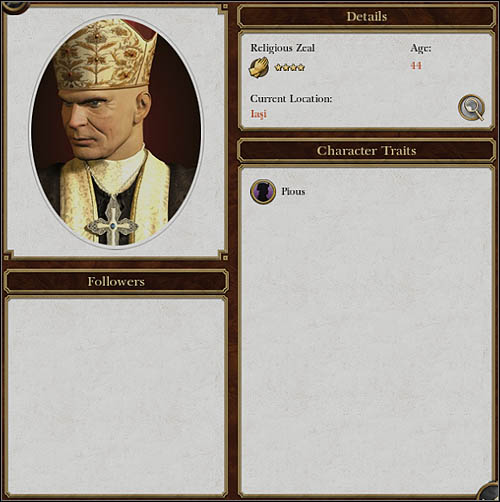
Major countries are characterized by a prestige level.

Prestige is a information about how developed is your country. If you will have strong army and navy and you will be good at new technologies you'll get prestige points (and your country is more powerful).
The best way to develop is to make a war. It will force you to make some army (sometimes you have to build some ships). You will need gold for this, so be sure that your agriculture and industry are in very good condition - build some farms and factories in your provinces. All of this can be supported with technology. Put some intelligent men in laboratories and force them to work there. Inventing some interesting technologies can result in more developed country. In addition you will gain some prestige points.
Sometimes prestige level can be the only win condition. You can set the option "prestige win" in the options (then you have to have the best prestige level at the end of the XVIII century).
 This the diagram from the end of the Austrian campaign. As we can see: you can have high prestige level only because of the army.
This the diagram from the end of the Austrian campaign. As we can see: you can have high prestige level only because of the army.
Erection of cities is possible only when you are making some new buildings. At the beginning you won't be able to build nothing more than just a administration building and dome fortifications.

You can say that these are the most essential buildings that you can make in your city. If you will click with the right mouse button on the building icon you will see how can you benefit from this structure. For example: administration buildings can result in a higher tax income, higher level of happiness and the will allow you to train weak infantry.
Every building has a few levels of development. On the next level (in most cases) he will grant you a better bonus than on the previous one. For example: State House will give you 4% bonus to tax income and the Governor's Palace - 6%
With low taxes and high wealth rate, you town will be grow very quickly (as a matter of fact you will be able to use new building slots and construct some barracks, admiralty, cannon foundry, etc.
 Town with the maximum number of building slots
Town with the maximum number of building slots
remember: build only these building which are most useful for you at the moment:
1. If you have a war then raise some military academies and cannon foundries.
2. In the heart of your country build some cultural buildings to raise happiness of your citizens and make your prestige level much higher. In addition, the highest level of development of each cultural building (academy, observatory) allows you to recruit gentlemen.
3. Try to have at least one admiralty and it's improvements. As a matter of fact, you will be able to develop technologies connected with navy. Moreover, admiralties will raise your prestige level.
Look at the picture above and notice that red bars located near buildings portraits. They means that the construction is damaged and need to be repaired. It can cost you much of your gold, but in most cases it is necessary (building with red bars do not fulfills their functions).
Minor cities are growing in developing regions. The speed of its development depends on taxes and region wealth.
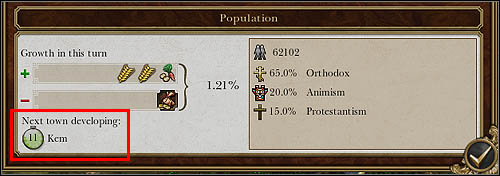 In the region tab you can check how long you have to wait for the next city (in turns).
In the region tab you can check how long you have to wait for the next city (in turns).
In these town you can build many types of buildings. We can divide them into four categories:
1. educational centers (schools, universities) - they are needed to make any technological development; they train gentlemen
2. entertainment centers (inns, gardens) - they train carousers, rising happiness level;
3. industrial and agricultural centers (farms, lumber-mills, mines) - they generates income, improves general wealth of the citizens and supports technology
4. religious centers (churches, seminaries) - raises happiness, trains priests and support returning of your citizens
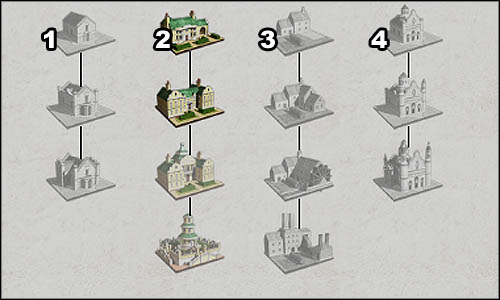
Is up to you where you want to build each type of building. Remember that every center is important, but also note that you have to keep appropriate proportions (15% of entertain canters, 80% of industrial centers and 5% of religious centers) . Medium sized country should also have 3 or 4 educational centers.
In each turn look for towns that have nothing more to build. The best is to build the highest level buildings as fast as possible.
IMPORTANT! Educational buildings are often the first target of your enemy. Opponent troops are plundering them and, as a matter of fact, other buildings are unable to function. It is very important in the case of technology centers (they need to function all the time). It is good to some soldiers near them in the high risk areas.
Remember that if some buildings are unnecessary you can always destroy them. In the next turn you will be able to build something new on their space.
If the town is near the sea you will be able to build some trading ports, major fisheries and shipyards.
Trading ports are most important because they allow you to gain some very high incomes. Try to build them always when it is possible (near oceans, Mediterranean Sea, North Sea, Mexican Gulf). As a matter of fact you will be able to create some new trade routes with other countries. In addition, all ships constructed in trading ports will have easier access to colonies.
Major Fisheries are not so popular. Mostly because of the fact that your population can make a living only with land farms. But if some region is very poor, you can try to build one. Personally, I do not often do that because the are much worse that trading ports.
Military shipyards are used to build some huge military units. You don't need to have them in large numbers (3 or 4 for Europe or America is enough). Often build them near the borders of your country (vessels will be ready to attack very fast). Do not place them in gulf or inner seas (Black Sea can be easily conquered in the other way).
In the other words - roads. They are not that important as buildings in cities and towns, but if you have too much cash do not hesitate to improve them. The higher level of roads will result in better incomes and higher speed of army movement. Remember that the highest level of roads will boost your prestige level.

Note, that incomes are mostly gained from taxes. Their level can be set for the whole country in the special tab, called Tax Tab.
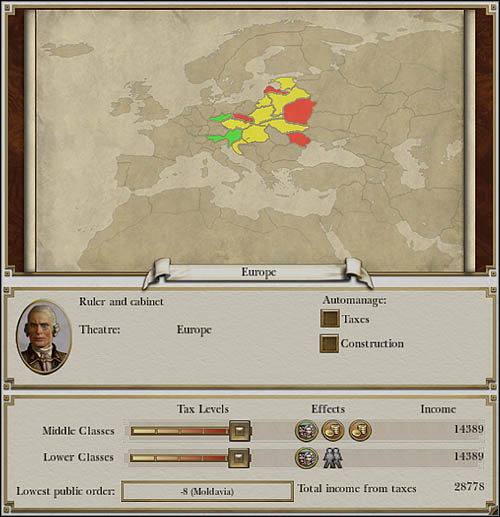
On the picture below taxes are at the maximum level. As you can see there are separate bars for middle class and lower class citizens.
Taxes rates can result in many things. If you will set them on low level then your incomes will be smaller but citizens would be more happy and much wealthier.
When you will set taxes rates as it is shown on the picture above, it will result in <br>social dissatisfaction and may lead to riots. The death rate in the lower class will be very high and the population will be divided. Instead of this your incomes will be very high. The most important thing is to find a golden mean.
After you will set the tax rate, look at the map located above. Green color means that the people are happy, orange that they are disappointed. Red color is an alert: your citizens are unhappy and there is a high risk of riots, revolt, etc.
Happiness level in every city can be checked by looking in the detailed information tab of each city. Note that lower class citizens are often more unhappy that the middle class. That's why you must be extremely careful when you are setting tax rates for most poor people.

Don't forget that tax rates can be always automatically set by the computer.
Riots are the result of people unhappiness. You can check this statistic for each province.

If these statistics are below zero, you may expect some troubles.
Act I: It starts with the workers protest. It is a warning that some provinces may have some real problems.
Act II: Now we have riots. During this faze some building may be damaged (as a matter of fact they won't be working properly).
Act III: If the strike is in the less important province then it may be taken by the rebels. Also when the province was an independent country in the past its citizens may want to be independent once again.
Act IV: when the revolution will come to the capital city a special group of rebels will be created. Their goal will be to abolish the ruler and his cabinet. In this situation you may have to chose if you want to stand upon the rebels or the present cabinet.
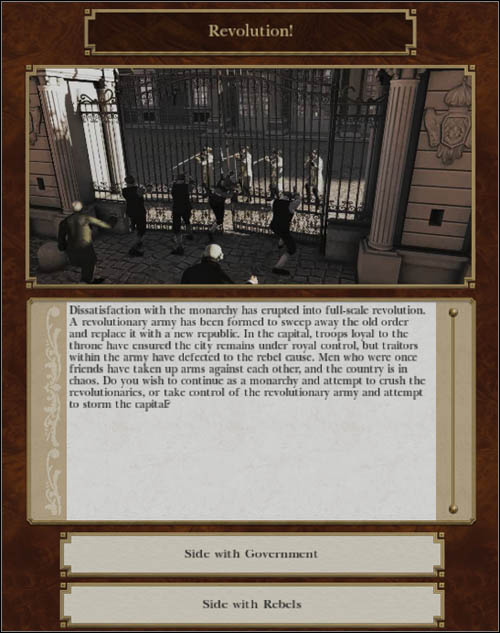
When you will chose to support the present cabinet you will have to defeat army of the rebels in few battles. But if you want to join revolutionists, you will have to conquer the capital city. In the second option the general happiness level of your citizens will increase as a result of the changes in political system.
WARNING! If you will be defeated (no matter on which side) the campaign will immediately end.
1. Remember than you can react immediately. For example you can decrease taxes. These type of action will change situation in the whole country.
 If you have taxes at the maximum level riots are certain
If you have taxes at the maximum level riots are certain
2. If there is a good situation in the whole country and only one province is getting on your nerves then you can try to exempt this region from tax. You can enable this option in the proper check box.

3. A very effective way to prevent the revolution is to deploy some more regiments in provinces with higher risk of rebel. You will be able to see revolutionists army on the map. Defeat them and the local people will loose faith that they can change anything.
4. Sometimes riots can be result of the religious differences. Send there some priests to calm down the situation.
5. Sometimes the only thing you have to do is to increase repressions - build some administration buildings.
6. If your citizens need some more entertainment build theater or opera house.
7. Change your justice minister - new politician may be better at repressing your people. You can also decide to organize earlier elections. This option can be good only if all your ministers have poor statistics (this solution cannot be performed in absolute monarchy).
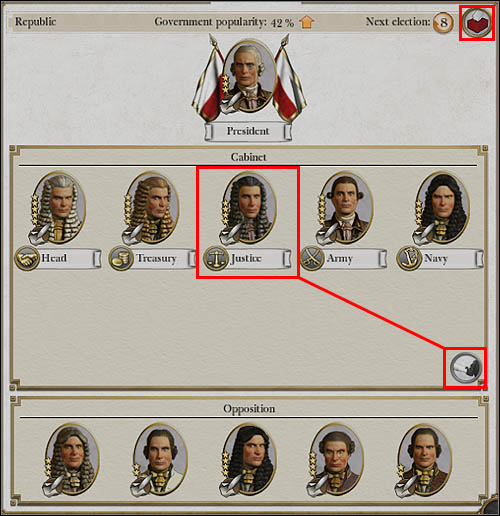 Justice minister or the whole government - the choice is yours.
Justice minister or the whole government - the choice is yours.
Diplomatic relations between two countries can be symbolized in two ways. The first one is a short, text definition. The relation can be: unfriendly, friendly, hostile, etc.
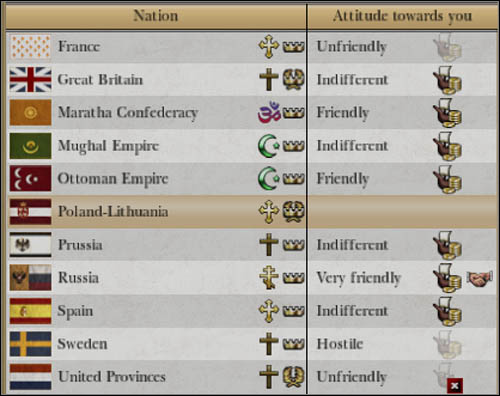
You can always check the relation status between countries in a more detailed way. Turn on your diplomatic negotiations panel and choose one country. If you will move mouse cursor on the other provinces you will see what they are thinking about the selected nation.
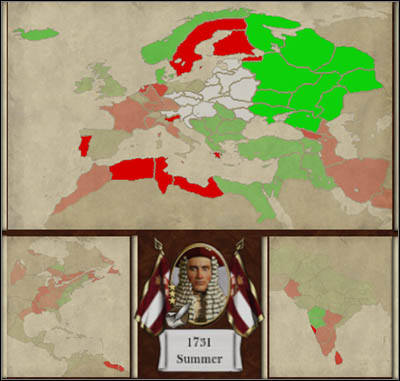
Relation between two countries can be result of many different things: similarity of political system, religion, trade contracts, territorial expansion, deals with other countries and, at last, war.
Statistics that are below zero (provinces are marked with red) means that nation is rather reluctant. On the other hand, numbers above zero (provinces marked with green) means that the situation is good. It is obvious that you can negotiate more with countries that has positive relations with you.
You can change your relationships with other countries. If you want to read some more informations - read the next chapter.
Diplomatic agreements can benefit in many ways. You can gain some economical or (and) territorial privileges.
Trade agreements are important, because they are always very profitable. Note that, the more trading ports and land trade routes you have, the more trade agreements you will be able to sign.
Try to create trade routes to every possible country. First of all you should talk with nations that are very far away. For example if you are playing with Russia or Prussia try to talk with Mongols or Marats. You will gain some rare and expensive goods (tobacco, etc.). The next step is to talk with your neighbors. - generally the more trade partners will you have the more cash you will receive.
If you can't create a trade route with some nation the red cross will be shown on the ship symbol in the special panel.
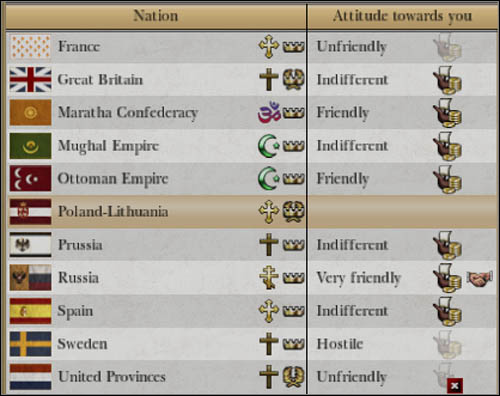 The Republic of Poland is trading with all countries except France and Sweden. The is also no possibility to set a trade route with United Provinces.
The Republic of Poland is trading with all countries except France and Sweden. The is also no possibility to set a trade route with United Provinces.
Trade agreements may result in good diplomatic relations between countries.
Sometimes it may happen that some countries will want to exchange regions with you. You should think couple of times before the decision. First of all you must to look at the level of development of the proposed area. The most important regions are these with trade ports and big cities (in Polish campaign good exchange proposition is Gdansk for Krolewiec)
In most of cases other countries will offer you regions that are poorly developed. You must check, if the areas that they want are required to your victory. If the answer is "Yes", then your decision will be simple (I think it is obvious why).
Try to decide if you want to declare war to the country that you're negotiating with at the moment. Remember that taking his lands may result in much more simple invasion in the future. Moreover, your enemy will be unable to fortificate in a very short time. That means that maybe you will be able to take away from him areas that you have given him in the past.
If you are underdeveloped in technology then you can exchange some territories for industrial or military improvements. Remember not to give away areas that are very important (especially that with access to the sea). It is possible that new technologies will raise your chances in the future war with the present diplomacy partner.
You can always simply sell your regions to the opponent. I must say that this decision is not very typical. There are not many moments in the game when you don't have cash for a long time. That's why you won't be forced to sell your areas for gold.
Foreign countries are very envious about their lands. If you will propose to change territories, in most cases the proposition will be withdrawn.
High quality China, expensive jewelery and horses are the most welcome gifts. If you will give to the another country the relations with it will be immediately improved. Remember that gifts must be interpreted as a disinterested (you cannot send them with, for example, trade agreement offer). There is also no sense in sending gifts to countries with whom you have a war at the moment.
Relations improved by the gifts should be used very quickly. In a short time send some trade agreement proposition, etc.
It is possible to demand a military access, or in the other words - a right to march through the enemy territory. That kind of agreement can last for 5, 10, 20 turn or it can has no time limitations. However, it is hard to sign it. Every country will be cautious - they fear that your troops can attack their cities. It is good to offer some valuable goods with that proposition.
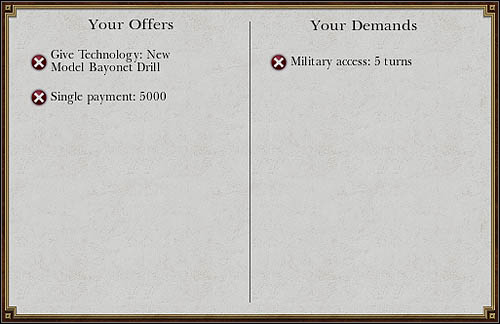 Military access in French cost me 5 000 and one technology.
Military access in French cost me 5 000 and one technology.
In most cases, player is the person who is declaring war. You can do it on paper but it doesn't make any sense. You can do it only when you want to improve your relations with another country ("declare war to my friends enemy").
The best option is to declare war simply by the attack on the enemy territory. Your opponent will not have enough time to strengthen his boarder forts. Moreover, if you will take some provinces quickly this may result in riots in the enemy capital city (reaction for the lost fights).
Sooner or later most the world will hate you for the territory expansion. There is nothing wrong with that. The goal in most of the campaigns is to conquer some new areas. It is normal that some countries will be scared.
In the higher levels of difficulty other countries can declare a war to you. Especially when they will notice that some of provinces are unsecured. The peace can be achieved in two ways: you may pay a tribute or simply defeat your enemy on the battlefield. In most cases peace is a matter of two battles or one province.
When you have very good relations with some nations you can make an alliance with them. It may result in even better relations and will allow you to demand a military support. When someone is declaring war to you, you can ask your allies for help. If you are declaring a war do not call your friends (if you will do that you will be forced to share conquered territory with your allies).
Alliance will allow you to sign trade or military agreements easier and quicker. It is connected with the relations between countries - the better they are, the faster you can sign an agreement with them.
Alliance is a good way to trick your enemy. When you are going to attack your opponent simply sign an alliance with him (or patronage, it is almost the same) and note that you also want a military access. You will be able to enter enemy territory with your troops and conquer some provinces and cities. However, that kind of behavior can result in worse relations with other countries - they may think that you cannot be trusted.
Patronage is a way to gain some additional money. If you are a protector of a small country you will be able to take part of its incomes. In return you will have to give them some military aid in case of the invasion (it is happening extremely rarely, because minor countries in most cases have a strong army). Remember that patronage is connected with the military access for both countries. When you will have a war nations that are under your patronage will join the conflict (as normal allies).
It is quite simple to sign a patronage. Especially when your potential partners are your neighbors and you have a strong and huge army.
1. I advise you to work on that technologies that can grant you an access to better constructions (farms, factories, schools, etc.) For example you can work on bayonets, improvements in army, and some ideas (like utilitarianism). To make it simple: these are technologies located on the left side of the achievement tree.
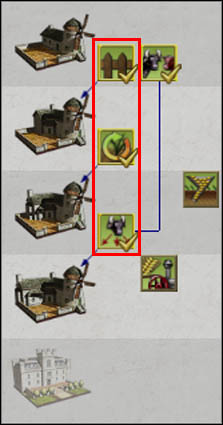
Why these improvements are so important? As I said before: they allow you to construct new structures that can raise prestige level of your country and allow you to do research on some new technologies. Thanks to them, your country can develop quickly.
2. Science centers are the places that are most often attacked by the enemy soldiers. If you are in the state of war with one of your neighbors, better send some more troops to there.
3. I think you'll be reasonable, but I will write that there is no sense in doing research on technologies that are not useful for you. For example: if you do not have access to the sea do not develop technologies connected with navy.
4. Muskets are the most important element of every land battle. As a matter of fact you will need to improve these weapons. The first thing is to grant them Ring Bayonets or Socket Bayonets, instead of Plug Bayonets. Moreover you will need the Fire by Rank ability and Square Formation. Do not forget about industry and agriculture - but there are no very important technologies.
5. To develop your technology very quickly you will need some agents (gentlemen). Build some cultural or educational constructions (academies, observatories, etc.) to grant yourself a stable access to very intelligent workers. Deploy them in research centers to support the development.
 With selected building you will be able to recruit gentlemen
With selected building you will be able to recruit gentlemen
As you may know from the chapter called "Region Management", research centers can be build in new cities (in Poland it may be Cracow or Lublin, in Great Britain - Cambridge, etc.).
You will start with one research center. This is not too much. I advise you to create at least 3 or 4. Each of them will be able to work on another branch of development. The first one will take improvements of your land troops, the second one - navy, third one - agriculture and industry and the last one - ideology achievements.
 Each center can work on another branch of development.
Each center can work on another branch of development.
Research centers cannot work effectively without gentlemen. Check your scholars and learn in which branch of science they are good at. If you have many researchers with an ability called Armchair General, order them to work on military technologies. The same with the other branches. With this strategy you will be able to create research centers that are good in one special thing (they will be working much faster).
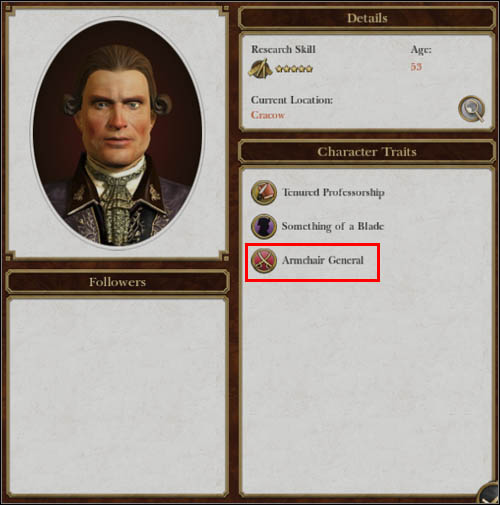 Armchair General will help you to develop military technologies much faster
Armchair General will help you to develop military technologies much faster
Gentlemen can be recruit in cities with observatory or academy.
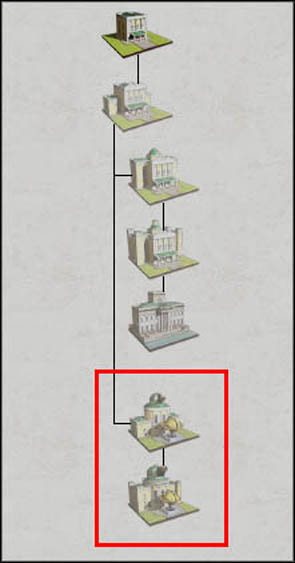 You must have buildings marked with red to recruit gentlemen
You must have buildings marked with red to recruit gentlemen
Gentlemen are people who are very good in doing research. Like with other agents new gentlemen are joining you population every few rounds. They are appearing in big cities with observatory or academy or in research centers.
Gentleman can work on developing new technologies. When they will be ready, deploy them at the proper research center. Their abilities should come up with branch on which center in working at the moment. If you have gentleman with the ability Armchair General then put him in the military research center, the same with the other branches of science.
Gentleman can steal technology from your opponent. Order your scholar to go to the enemy research center. When he will be there (he can stay there without any consequences) the option to steal technology will be activated. You can try to learn technology that is known to your opponent and that is completely new for you. The chances of successful action (in percents) are depended on how advanced is the new technology and on the prestige of your gentleman.
Gentleman can duel. If you want you may order your gentleman to duel enemy scholar or rake. Chances of winning are expressed in percentage (it depends on a prestige of researcher). Remember that in duels your opponent will have an opportunity to chose a weapon. As a matter of fact even a very good gentleman can loose a fight if his opponent is better at one weapon (pistol or rapier). One more thing: in most cases gentlemen are better in duels than rakes.
You can recruit some rakes by building some Coaching Inns (and every more advanced type of this building).
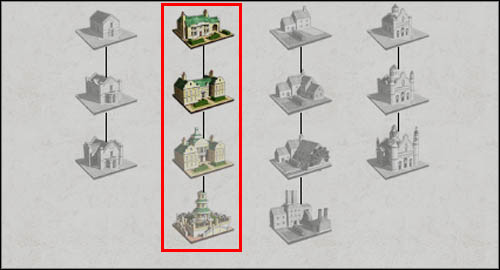 If you want to recruit rakes create one of the buildings marked with red.
If you want to recruit rakes create one of the buildings marked with red.
Rakes are thugs which are doing things that any government cannot admit that they're happening, for example: they are spying. The higher abilities rake has, the most probable is to infiltrate enemy fort, town or village. He can inform you what kind of units are in the enemy fortress and how many.
Rakes can kill enemy characters. They may assassinate opponents generals, priests, gentlemen and rakes. The more experienced your rake is the more probable that the action will end with success.
Rakes can sabotage buildings located on the enemy territory. If you want to damage your opponent economy, technology development, etc., order your thug to blow up an enemy construction (farm, school, opera house, etc.). Damaged buildings cannot function until they will be repaired.
Rakes can assault merchants that are using trade routes. Go to your neighbors land and look for some trade routes. When you will find some, then order your rake to attack caravans (try to choose these routes that are not used by you and your allies). That will grant you some money.
Priests are trained in churches, Jesuit colleges and seminaries that can be built in smaller cities.
 If you want to recruit priests build some churches in one of you smaller cities.
If you want to recruit priests build some churches in one of you smaller cities.
Priests are teaching their own religion in the province where they are. Catholic priests are teaching catholicism, imams - Islam, etc. If you will conquer new area when the religion is different from yours, you can send there priests to return the people. As a matter of fact the level of happiness will raise.
Priests can cause some civil unrest at the enemy territory. If you will send some of your priests to your opponent cities social dissatisfaction will raise because of the new religion. It may result in riots. As a matter of fact your enemy will be forced to lower the taxes to prevent the rebel and that will result in lower incomes.
On the next few pages of this guide you will find some useful information about the units that are available in the Empire: Total War. Evaluation of each unit is a matter of personal approach to the game and may be debatable.
In the handbook only core units are presented (that means soldiers that can be trained by each fraction in their home regions). Each description consists of:
1. Name;
2. short description (firepower, shooting range, cost, number, etc.);
3. list of countries that can produce each unit (still we are talking about home regions)
I am sure that with this guide you will be able to learn how to use each type of unit in the game. The experience, that you will gain in your first battles will help you to evaluate the importance of each unit that you will be able to create.
Units are in the alphabetical order.
Description: slightly better than landless rabble (peasants have guns), but still no revelations. They are in small numbers, and they have modest accuracy and small amount of ammunition.
Armies: Marat Confederation
Description: similar to Rangers or Siberian Hunters in other countries. Azzars have a shooting range larger than the typical infantry, and they can move in cover. You can organize traps with them, attack flank in silence and secretly pass near the enemy artillery. Unfortunately, they are too good in melee combat.
Armies: Ottoman Empire
Description: typical line infantry. Slightly better that the Hindu Musketeers, but they are much worse in melee combat. They are physically and mentally resistant (the best defense and morale factors of simple units), so use them to defend some sensitive points.
Armies: Marat Confederation
Description: infantry that is quite good in melee combat, both: on the battlefields and in the buildings. Bashi-Bazouks are able to kill infantry units and militia very effectively. However they are very defenseless against cavalry (their regiments consists from less than a hundred of soldiers) .
Armies: Ottoman Empire
Description: they are equipped with grenades. They are very good in flank attacks. Thanks to their bombs they can kill many of the enemy soldiers in a very short time. They are not as good as European Grenadiers, because they cannot fight effectively in melee combat.
Armies: Ottoman Empire
Description: very good units, very useful and worth to be popularized in the Turkish army. Change Isarelys with them to change your army from peasantry to regular , tough soldiers. They have very good shooting abilities and they have high morale
Armies: Ottoman Empire
Description: Machined Rifling is needed. They are very bad in melee combat. Their advantage is a very large shooting range and short time of reloading. As a matter of fact, they can be extremely useful in every battle against musketeers.
Armies: Spain
Description: very good at melee combat. If you like Bashi-bazouks, then think about recruiting some Cemaat Janissaries. They are much better in fights against infantry - both in the battlefield and buildings. They have only one flaw: they cannot hide.
Armies: Ottoman Empire
Description: Light Infantry Doctrine is needed. French Chasseurs-a-Pied are very similar to the every light infantry in the other countries. The are good at guns and slightly worse in melee combat. They can deploy stakes and they have much larger shooting range. Their flaw is that they can be found in small numbers.
Armies: France
Description: Light Infantry Doctrine is needed. They are very similar to the Light Infantry but they have much better shooting range. In fact they are not as good as line infantry in melee combat (mainly because of their morale level). They can deploy stakes to stop the cavalry.
Armies: Great Britain
Description: very expensive but very good infantry. They are reloading their guns very quickly, have very good accuracy. In addition the are very good in melee combat and have very high morale level. If you can, buy them immediately. You will be able to train them when your country will be quite wealthy (so should be no problem with money).
Armies: Great Britain
Description: Light Infantry Doctrine is needed. Quite good infantry, especially with musket fights. They can deploy stakes to stop cavalry and they have quite long shooting range. Their only flaw is that they are not numerous.
Armies: France, Spain, Netherlands, Great Britain
Description: countries with colonies can train these units. They are very good because the have slightly higher statistics and they are much cheaper. Their cost of living is higher but it shouldn't be a problem.
Armies: France, Spain, Netherlands, Great Britain
Description: good infantry, mostly because of their number and low cost. It cannot be formed in advanced formations but is ideal to keep peace in cities. In American campaign it can be used as a reinforcement but never as a main army.
Armies: France, Spain, Netherlands, Great Britain, British Colonies
Description: Its good to have couple of these units in your army at start. It can be used to fight against enemy infantry and, in large numbers, with other infantry. However, beware of opponent grenadiers and infantry with bayonets. This unit can be replaces with musketeers with bayonets.
Armies: Thirteen Colonies
Description: in very huge numbers but its very poor. Cheaper than militia. Train this unit only to keep peace in the cities. You do not want to use them in battles (militia is better). They can be recruit only in republics.
Armies: Netherlands
Description: quite good at the beginning (before you will able to train typical line infantry). Cossack have a good shooting range and reloading time. They have two major disadvantages: accuracy and melee combat. They don't use bayonets, but they will be useful in Crimea, Chechnya and Georgia.
Armies: Russia
Description: In small numbers and has not very high statistics. The good thing is that they are cheap. They can be used to set traps and attack from the flank. They are able to hide. In addition they have very good shooting range. Remember that this unit cannot use bayonets.
Armies: France
Description: a very good militia. They don't have very good statistics but you can use them at the beginning. Their strength is in their number (more than a 100 people in one regiment). They can be replaced with Isarelys.
Armies: Ottoman Empire
Description: very similar to line infantry. The only differences are in the price and morale. They will help you to save some money. In addition they are quite good in fight.
Armies: Austria, Spain Netherlands, Prussia, Russia, Republic of Poland, Sweden, Thirteen Colonies
Description: Screw Breach needed. Quite similar to Green Jackets. Ferguson Riflemen have a great time of reloading and very long shooting range. On the other hand they cannot fight in melee combat without bayonets and proper training.
Armies: Great Britain
Description: cannon fodder in its pure form. They are fighting only when the are forces to defend their city. They cost nothing, but they are worth nothing more. They have quite good shooting ability, but they will be killed in melee combat very quickly.
Armies: Austria, France, Spain, Ottoman Empire, Marat Confederation, Netherlands, Prussia, Russia, Republic of Poland, Sweden, Thirteen Colonies, Great Britain
Description: they can't be found in huge number, statistics are much lower than in the line infantry. The good thing is that they are very cheap. They can hide and they have quite a long range (as a matter of fact they can organize traps and attacks from flanks). They do not use bayonets.
Armies: Spain
Description: nothing to say, very poor infantry and it can only fight in close combat. They be effective only with peasantry. Try to replace them with Cossack Infantry.
Armies: Russia
Description: They are expensive and not numerous. These flaws are repaid with their good side and these are: very good firepower, quick reloading and the ability to use grenades. Two units of grenadiers can fight with almost every infantry (almost because they won't be affective against infantry with long shooting range). Their explosions are good to lower the enemy morale level.
Armies: Austria, France, Spain, Prussia, Republic of Poland, Sweden, Thirteen Colonies, Great Britain
Description: Screw Breach needed. Very good shooting unit. They have tremendous accuracy and shooting range, the time of reloading is also very good. In addition they can dangerous in close combat, but do not use them to that kind of fights (because of their small numbers).
Armies: Great Britain
Description: great, numerous infantry; very good at defense and attack. They have very high morale level, better even that grenadiers. They have great defensive statistics and, as a matter of fact, they can be useful on the battlefield. Their disadvantage is the limit of maximum regiments of this unit in your army.
Armies: Spain, Prussia, Russia, Republic of Poland, Sweden, Great Britain
Description: they are worse than similar units like frontiersmen and Coureurs de Bois. However they can be very dangerous, mostly because of the ability to move in the cover and to organize traps.
Armies: Spain
Description: Hand Mortar Company are using something like rocket launchers. As a matter of fact they have shooting range similar to the most of the infantry units (twice as long as grenadiers shooting range). Hand Mortar Company should support line infantry in the battlefield. The flaws are: not many grenades and very long time from launch to explosion.
Armies: Russia
Description: Cheap but not very numerous. If you're looking for the better replacement for the light infantry try to use Hessian Line Infantry. They are good at supporting other regiments and defending your artillery.
Armies: Great Britain
Description: something between guards and grenadiers. They have quite good morale and very good charge. Scots are very good on the battlefield but the are very expensive too.
Armies: Great Britain
Description: they have to be a base of your army from the very beginning. Armed with muskets, they have very good accuracy and average statistics in melee combat. In close combat they can replaced by Hindu Warriors.
Armies: Marat Confederation
Description: they are fighting with swords. At the beginning of the game they may help to crush enemy infantry (especially when your opponent wants to fight in close combat too) and cavalry.
Armies: Marat Confederation
Description: these units are almost the same as line infantry. Infanterie Petits-Vieux are slightly faster at reloading. They have also better defensive statistics and... much higher price.
Armies: France
Description: very good morale, great accuracy and proper reloading time. The price is quite high but they are worth their price. It is very rare in the French army but Infanterie Vieux can mobilize other units to fight
Armies: France
Description: very similar to the line infantry, cheap and it is available almost from the beginning. Is good to have them while fighting in Morocco. The minus is that they have very harsh maximum limit of units.
Armies: Spain
Description: very good line infantry, especially at the beginning. They have good reloading time and shooting range. They are also very numerous. The only disadvantage is their close combat abilities (they are worse that the European line infantry).
Armies: Ottoman Empire
Description: in the first phase of the American campaign they should be the main power of your army. But it is a matter of fact that you don't have too many units to buy. They are very numerous and their price is also reasonable. These soldiers can be enough for weak Indians but their disadvantage is the limit number.
Armies: Virginia Colonials
Description: a very unique infantry unit. They use something like rocket launchers to throw their grenades. They have very good shooting range (the same as normal infantry) and they could be useful in close combat. In addition their morale is on the high level. This unit should support line infantry in fight. Their flaws are significant: small number of carried grenades and a very long time between launch and explosion (cavalry can escape with no problems).
Armies: Ottoman Empire
Description: Light Infantry Doctrine needed. They are not too numerous, but they have really great shooting range. They are very good in shooting from a very long distance. They cannot manage in close combat and can be killed very easily. This unit is also very cheap.
Armies: Austria
Description: Kurdish Hillmen are quite similar to Azzars. They can hide in grass and trees and organize traps. They are good at shooting, have proper accuracy and good shooting range. On the other hand they cannot fight in close combat and they are not be able to move in cover.
Armies: Ottoman Empire
Description: just one word: tragedy. They can be found in very huge numbers (200 for the regiment) but they are very weak. Even the weakest group of infantry or militia can handle them. Landless Rabble are not fighting with guns they have only pitchforks. It is obvious that they must be very cheap.
Armies: Marat Confederation
Description: Light Infantry Doctrine needed. Small units of light infantry have a very low living cost. They have better shooting range than the typical line infantry (they can be used as shooters in the battle). They are weak in close combat. It is good to notice that they can deploy stakes to stop the cavalry.
Armies: Netherlands, Prussia, Russia, Republic of Poland, Sweden, Thirteen Colonies, Great Britain
Description: good in the battlefield and very numerous. It is the main military power in all of the European armies. Equip the with bayonets so they can manage with cavalry. Train them as often as possible because their worth it.
Armies: Austria, France, Spain, Netherlands, Prussia, Russia, Republic of Poland, Sweden Thirteen Colonies, Great Britain
Description: very good unit with proper shooting ability. They have long shooting range and can deploy stakes against cavalry. Flaws: the are in small number and they have very long training process (two turns).
Armies: Thirteen Colonies
Description: great unit. The are not such good in shooting as rangers but they are great in melee combat and defense. If you have enough money you can train them.
Armies: France
Description: they are the best in defending cities. They are not trained very well and do not have high morale too. Their good sides are their numbers (160 people in one regiment). As ma matter of fact they can be treated as a cannon fodder.
Armies: Austria, France, Spain, Netherlands, Prussia, Poland, Sweden Thirteen Colonies, Great Britain
Description: the main power, especially at the beginning of the campaign. They are very cheap and can be use in attack and defense. Equip them with bayonets so they will be able to fight with cavalry. Their main disadvantage is their morale level. They can sometime escape from the battlefield.
Armies: Thirteen Colonies
Description: they are very similar to the militia. They have actually two main differences: Minutemen have more ammunition and more defensive points.. The rest is the same as with militia. However, i prefer to use Militia Infantry in the battle - it is hard to use all ammunition in one battle.
Armies: Thirteen Colonies
Description: very poor unit. They can't do almost nothing. The only advantage is their number: 200 people in one regiment and the price.
Armies: Ottoman Empire
Description: they are not worth their price. Main disadvantages are: very long reloading time, bad defensive stats and average accuracy.
Armies: British Colonies
Description: not so useful unit bit it has some good sides. The first thing is shooting range (the best at the beginning) and the price. Because of their number and armor they cannot be used in close combat. They can move in the cover so you can use them as to organize some traps and as a support for line infantry.
Armies: France, Netherlands, Spain
Description: very weak musketeers and in addition they are not very numerous. In fact it is good to have them in your army. They can hide very well on the battlefield and they are quite cheap. The other thing is that, in my opinion, they can better guard conquer Indian tribes.
Armies: France, Spain, Netherlands, Great Britain
Description: they can be ignored. They can kill some militia for example but the better choice is to wait for better troops (that can use guns) and then recruit them.
Armies: France, Spain, Netherlands, Great Britain
Description: European Doctrine needed. The next, after Isarelys and Beylik Janissary Musketeers, kind of infantry in which you can invest as many money as you want. It is very similar to the line infantry and it will be good at the battlefield. It should be a base of your army.
Armies: Ottoman Empire
Description: European Doctrine needed. It is a copy of European light infantry. They have the longer shooting range than the line infantry and they are able to deploy stakes. Quite good unit if it is used as a support for line infantry units.
Armies: Ottoman Empire
Description: European Doctrine i Machined Rifling needed. Similar to Rangers from the European army. They have good accuracy and great reloading time and shooting range. They are very useful to kill some infantry units and charging cavalry. They cannot fight in close combat.
Armies: Ottoman Empire
Description: they are very useful with the charging cavalry. Unfortunately they cannot fight with musketeers. In addition they have less defense points that colonial pikemen. That's why it is so important to equip other units with bayonets. Pikemen have to been replaced with more universal shooting units.
Armies: Austria, France, Spain, Netherlands, Prussia, Republic of Poland, Sweden, Great Britain
Description: better than Firelock Armed Populace but they cannot manage even with militia. They can hide in grass but even that ability cannot help them. They can be deployed in cities as peace keepers.
Armies: Austria
Description: Machined Rifling needed. They are typical shooters. The have very good accuracy, reloading time and shooting range. They can be used to kill infantry units and charging cavalry. They are very poor in close combat ( do not charge with them).
Armies: Prussia
Description: not very numerous infantry with worse stats that the typical line infantry. They can hide and they have very good shooting range - as a matter of fact they can be used to organize some traps. They don't use bayonets, so they won't be able to fight in close combat.
Armies: Thirteen Colonies, Great Britain
Description: they have worse stats than typical line infantry but they can be trained faster. They are good if you want to use them as a reinforcement for your border army. The disadvantage of this unit is a maximum number of regiments that you may have in your army.
Armies: France
Description: great unit. They are not as good as Rangers in shooting but they are very good in defense and close combat. If you have a lot of money you can try to train them. This unit is available in republics only
Armies: Netherlands, Thirteen Colonies
Description: Machined Rifling needed. This unit is great in shooting. The have very good accuracy and short time of reloading. In addition shooting range is tremendous. The only flaw is close combat abilities - they cannot fight in this way.
Armies: Russia, Republic of Poland, Netherlands, Thirteen Colonies
Description: they are very good and numerous (160). They have better stats than line infantry and very good morale level (it can influent other units in the army). Good accuracy and short time of reloading is also significant. Unfortunately they are expensive and they have a limit of maximum number of regiments in the army.
Armies: France
Description: very poor unit. They can be useful only at the very beginning but you must quickly change them with other units (for example Azzars).
Armies: Ottoman Empire
Description: sepoys are very similar line infantry. They have slightly lower stats and price. In addition they are available he colonies. As a matter of fact you will have to chose between them and VOC infantry. Choose them if you want to save some money.
Armies: Netherlands
Description: not so numerous infantry with a bit worse stats than in the line infantry. They can hide and they have very good shooting range - as a matter of fact they can be used to organize some traps. They don't use bayonets, so they won't be able to fight in close combat.
Armies: Russia
Description: very good and numerous infantry. They have better stats than line infantry: effective in close combat, proper shooting range and reloading time. The next thing is that they have very high morale (that can influence nearby allies). Only one flaw: very expensive.
Armies: Great Britain
Description: Machined Rifling needed. Tirailleurs are typical shooters. The have very good shooting range, great reloading time and accuracy. These stats must be balanced with average abilities of fighting in melee combat.
Armies: France
Description: line infantry that can be recruit in at the colonies. If you like infantry then VOC soldiers are ideal for you. If you do not have enough cash, then you be interested in cheaper sipays.
Armies: France
Description: Windbuchse needed. Similar to Jaegers - not so numerous but with slightly better stats. Unfortunately they are much more expensive than them. In addition they are available at the end of the campaign. Their advantage are very good hiding abilities.
Armies: Austria
Description: a very good lancer cavalry with a great charge. They can handle with groups of 80 infantry soldiers. They have only one disadvantage: they have very low defensive stats and can be killed very quickly in close combat.
Armies: Marat Confederation
Description: worse than Bargir Lancers. The are not useful and quite expensive. I do not recommend to buy them: low starts - they can only destroy artillery and some soldiers that are escaping from the battlefield.
Armies: Marat Confederation
Description: Carbines needed. I can say that it is a good cavalry: moderate stats, lots of ammos and quite good accuracy. Only their reloading time is a bit too long and they cannot fight in close combat. The best id to use them as a support.
Armies: Austria, France, Spain
Description: as a starting unit, they may be useful. They are good at shooting but their low defense stats do not allow them to fight in melee combat. As a matter of fact they cannot be used against infantry.
Armies: France
Description: this cavalry is very good in charging. Chevau-lgers cannot shoot but they have very good charge bonus. You will like them if you want to use cavalry.
Armies: France
Description: they are copy of Hussars. Cossack Ataman Cavalry have a very good charge and they can influent morale of nearby allies. You will like them if you want to use cavalry.
Armies: Russia
Description: Carbines needed. The are typical shooting cavalry. However, you cannot depend on them because of their weak charge. Later, you can change them with Dragoons.
Armies: Russia
Description: Carbines needed. The are exact copy of the normal dragoons. They can fight with horses and without them. They have a special bonus which affects the peace level in the city. They may be recruit only in colonies.
Armies: France, Spain, Netherlands, Great Britain
Description: very similar to province cavalry. They do not have good charge but they may be useful at the beginning of the game (for killing deserters and to eliminate artillery). Buy 2 or 3 units of this cavalry.
Armies: France, Spain, British Colonies
Description: a heavy cavalry with a very good charge (they can demolish regiments of good infantry). They are also very useful in eliminating the artillery. You can always deploy then on the wings. Try not to attack groups with 160 people - your cavalry won't be so effective and may be killed.
Armies: Austria, France, Spain, Prussia
Description: Carbines needed. They are quite good as a shooting cavalry, especially at the beginning. I do not recommend to use them for a long time - they have weak charge and are unable to fight effectively with infantry. Later you can change them with Sipahis.
Armies: Ottoman Empire
Description: Carbines needed. They are very universal unit. They are fast (good unit to surround the enemy or to attack from the flank) and they can get off their horses and shoot. They can be used to eliminate single artillery units. Their disadvantages are however similar: they not so numerous unit with not so good morale level. Last important thing: they have bonus to keep the peace in the city.
Armies: Netherlands, Prussia, Russia, Republic of Poland, Sweden, Thirteen Colonies, Great Britain
Description: personally, I think that this unit is completely useless. Their statistics are similar to pindari horsemen but they are not so numerous. In fact, they have quite a good charge (train them if you need something between good charge and with proper shooting abilities). It is quite expensive unit.
Armies: Marat Confederation
Description: major strength in land battles. They do not have the best charge bonus (but can kill many enemies with that ability), but note that this unit is great with close combat so they will be able to fight effectively will large number of infantry.
Armies: France
Description: Gendarmerie is very similar to Provincial Cavalry. They are quite cheap and they may be use in regular battles. They can attack infantry with no stakes and bayonets. This unit is also very good in keeping peace in cities.
Armies: France, Prussia
Description: this unit is moving with the commander of the army (at least it should be). They have quite good statistics but, as a matter of their number, they cannot be treated as a real military strength. They are able to kill some escaping soldiers and light cavalry. Try not to use them in regular fight if you have general with them (he may be killed).
WARNING! Generals in Marat Confederation are using elephants instead of horses. They are great in charging but try not to attack with them. They are very slow and your enemy can surround your unit very quickly.
Armies: Austria, France, Spain, Ottoman Empire, Marat Confederation, Netherlands, Prussia Russia, Republic of Poland, Sweden, Thirteen Colonies, Great Britain
Description: a very weak cavalry that has similar statistics to the Provincial Cavalry. The are very resistant to low temperatures so they won't be useful in your battles in south Europe. If you have some money you can use them in battles with Russians.
Armies: Sweden
Description: very nice unit. They have high charge bonus and, in addiction, they can also fight in close combat too. They can be used to kill enemy infantry and cavalry. Moreover they are very nice in normal cavalry jobs: eliminating artillery and killing deserters.
Armies: Sweden, Great Britain
Description: they are quite good unit at the beginning. The best is to use them against infantry regiments consisted of (maximum) 100 soldiers. They have not high defense stats so they cannot be used in close combat (especially when your opponent troops are equipped with bayonets). They are able to eliminate artillery and kill some deserters.
Armies: Austria, Spain, Prussia, Russia, Republic of Poland, Sweden
Description: very similar to provincial cavalry. In fact, they have higher stats and they also cost more money. They are good at typical cavalry jobs: charging the enemy, eliminating artillery, etc.
Armies: Austria
Description: a weak unit that can be used to charge enemy infantry regiments (like light infantry or militia). Hussars are numerous (60) so they can attack quite many opponents. Enemy artillery and escaping opponents are very good target for them.
Armies: Austria, Prussia, Russia, Republic of Poland, Great Britain
Description: slightly better than Heavy Cavalry. They have very high morale level and great close combat abilities. They are useful in charging enemy infantry, cavalry and artillery units.
Armies: Great Britain
Description: Carbines needed. Better than Dragoons (higher battle and defensive stats, morale level, etc.). Unfortunately they are no so numerous (only 45 soldiers in the regiment), so they are for players who are ready to pay loads of cash for training many units. In battles they are doing the same job as Dragoons - attacks from a flank, etc. They are very effective in keeping peace in cities.
Armies: Austria, Spain, Netherlands, Prussia, Russia, Republic of Poland, Sweden Thirteen Colonies, Great Britain
Description: you can try to train them but only if you do not have anything better at the moment. Indians are much worse that, for example, Carabineers but the price is almost the same. They main job is shoot at the enemy troop - the charge bonus is very poor.
Armies: Spain, Netherlands, Great Britain
Description: cavalry with very good charge. Unfortunately they have poor defensive stats so they have to watch out on pikemen or other troops with (for example) bayonets. They are good in killing weak infantry units. Moreover, you can use them to eliminate enemy artillery and some deserters.
Armies: France, Netherlands
Description: Carbines needed. This unit is similar to Shaturnal Camel Gunners. They have quite long reloading time and the shooting range is the same like in most infantry units. They are very effective at shooting at the enemy from the flank. Unfortunately they are quite expensive.
Armies: Marat Confederation
Description: it is quite worse that the Regiment of Horse. You can use them in battles but they are much butter in keeping peace in cities. In addition they are quite cheap. You can use them to attack weak enemy infantry units that do not have proper weapon against cavalry (spikes or bayonets).
Armies: Austria, Spain, Netherlands, Republic of Poland, Sweden, Thirteen Colonies
Description: with provincial cavalry it is the most essential horsemen unit. They are very important, especially at the beginning. Can be used against weak infantry regiments, to eliminate artillery and to kill some deserters. Beware of soldiers with spikes and bayonets.
Armies: Spain, Netherlands, Prussia, Russia, Republic of Poland, Sweden, Thirteen Colonies, Great Britain
Description: they are great support for the musketeers. Lancers are very good in close combat and they have also great charge bonus. They are stronger than most of the enemy infantry units, but remember do not send them under the enemy fire. The best is to deploy them on the side and attack enemy troops from the back.
Armies: Marat Confederation
Description: the are a very special unit. Camel Gunners have a great shooting range and they have a lot of ammo with them. Unfortunately they don't have enough defensive points to fight in close combat with infantry. Time of reloading is also too long. They can be used only as a support for better troops.
Armies: Marat Confederation
Description: the best cavalry unit in Marat and Turkish army. The have very good charge, high morale level and they are great in close combat too. They can very quickly attack your enemy from the flank or from the back. Only one flaw: the price is very high.
Armies: Ottoman Empire, Marat Confederation
Description: Tatars troops may be useful at the beginning of the game. They are equipped with bows and they have very good shooting range. Try to avoid engaging them in close combat fight - they will be killed very quickly.
Armies: Ottoman Empire, Russia
Description: cavalry with good charge and bad defensive stats. As a matter of fact, they cannot fight in close combat. Try to avoid infantry with bayonets. The are good for killing units like rangers, Siberian hunters, etc. They can effectively eliminate enemy artillery.
Armies: Austria, Republic of Poland
Description: weak unit; very similar to Regiment of Horse, but cheaper. It can be handy only at the beginning, when you don't have better unit (and gold) to recruit anything better.
Armies: Russia
Description: this is the same as the Regiment of Horse (the same stats). The only difference is that the VOC Cavalry is available in India.
Armies: Netherlands
Description: they have great charge bonus (the best in the game). Disadvantages are on the other hand, very significant: the are in small numbers and they do not have many defensive points. As a matter of fact elephants can be killed very easily. They can be also very dangerous to you troops (while escaping from the battlefield).
Armies: Marat Confederation
Description: a very good cavalry (one of the best in the game). It is great to smash enemy infantry (even when they are equipped with bayonets). Remember that they cannot be surrounded by the enemy troops, they can be killed very easily in close combat, because the are almost defenseless.
Armies: Republic of Poland
Description: this horsemen unit is slightly worse than Regiment of Horse. You can use them in battles, but they are much better in keeping peace in cities. In addition they are very cheap and you can train them as many as you want. In fights they can be used only against infantry with no bayonets or spikes.
Armies: Great Britain
Description: very weak unit with poor accuracy. They are also not good at long distances. This unit can be however useful to stop the charging infantry. Remember to use cannister shots then.
Armies: Thirteen Colonies
Description: Explosive Shells needed. They have a very long range but the accuracy isn't so good. They can use many types of ammo (grenades, carcasses, etc.) and, as a matter of fact, they can kill and fear enemy soldiers. They are very effective when shooting at large groups of enemy troops. The main disadvantage is that they cannot move in the battle.
Armies: Austria, France, Spain, Netherlands, Prussia, Russia, Sweden, Thirteen Colonies,, Great Britain
Description: Explosive Shells needed. They are slightly better than 3-lber Horse Artillery - stats are very similar. The good thing is that they are the only small type of gun that is available for European armies.
Armies: Austria, France, Spain, Netherlands, Prussia, Russia, Republic of Poland, Sweden, Thirteen Colonies,, Great Britain
Description: if you like artillery and you want to use it from the beginning then you cannot forget about 9-lber Artillery. They are not very strong but they are available from the beginning. This unit can be handy it couple of first battles, then change them to something better.
Armies: Ottoman Empire
Description: Cannister Shot needed. They are quite good for the beginning at the most important thing that they can move using horses and they can use many types of ammo. This unit can destroy city gates and enemy infantry units. In addition it is very cheap. Flaws? Very short shooting range.
Armies: Austria, France, Spain, Netherlands, Marat Confederation, Prussia, Russia, Republic of Poland, Sweden, Thirteen Colonies, Great Britain
Description: Explosive Shells needed. For this price it is a really good artillery. They can use a special type of ammo handle with big group of enemy cavalry. To be effective, they must be deployed in groups of three.
Armies: Austria, France, Spain, Netherlands, Prussia, Russia, Republic of Poland, Sweden, Thirteen Colonies, Great Britain
Description: they are very similar to 12-lber Foot Artillery (they have more firepower). The price shouldn't be a problem form you, especially when you are going to have some good artillery units in your army. They are filling the gap between 12-lber and 24-Iber cannons.
Armies: Ottoman Empire, Marat Confederation
Description: more expensive, more accurate and more power. Very effective in destroying buildings and fortress gates. This is one of the best artillery in many European armies.
Armies: Austria, France, Spain, Netherlands, Ottoman Empire Prussia, Russia, Republic of Poland, Sweden, Thirteen Colonies, Great Britain
Description: very good artillery. They have the same shooting range than normal 24-lber cannons but better accuracy and shorter time of reloading. In addition this unit have quite good morale level, what is very important in close combat fight.
Armies: France
Description: Explosive Shells needed . They have worse accuracy and firepower that the 24-lber Foot Artillery, but they are very effective at shooting at large groups of enemy soldiers to eliminate or scare them. They can use many types of ammo. This is one of the best artillery units in European armies.
Armies: Austria, France, Spain, Netherlands, Ottoman Empire, Prussia, Russia, Republic of Poland, Sweden, Thirteen Colonies, Great Britain
Description: it is hard to get more powerful artillery on the battlefield. They have shorter shooting range than mortars but the firepower is really great. They can be use to kill enemy soldiers (both infantry and cavalry). They are also good with destroying buildings but they cannot move in the battle so some constructions may be out of range
Armies: Ottoman Empire, Marat Confederation
Description: Explosive Shells needed. Standard mortar, very similar to the European 4-inch Mortar Battery. They have marvelous shooting range and they can use many types of different ammo. They are good to scare and eliminate enemy troop, but they cannot handle with the building. They cannot move in the battle.
Armies: Ottoman Empire
Description: they may be useful when you're shooting at the enemy fortifications. I do not recommend to use them on the battlefield, they can only irritate your opponent. Moreover you cannot move them after deploying at the beginning of the battle.
Armies: Marat Confederation
Description: Demi-Cannons are slightly better than sakers. They can move, so you can drive them near the enemy troops and fortifications. They may be also useful in attacking opponent infantry and cavalry, especially at the beginning of the game.
Armies: Austria, France, Spain, Netherlands, Prussia, Russia, Republic of Poland, Sweden, Thirteen Colonies, Great Britain
Description: you can use them only for destroying enemy fortifications. They cannot be very effective against enemy troops, mostly because of their low accuracy. Moreover you cannot move them after deploying at the beginning of the battle.
Armies: Marat Confederation
Description: Explosive Shells needed. It is very similar to Mortars i and the European 4-inch Mortar Battery. All of these units have the same accuracy, morale and shooting range. One difference is that Large Mortars have a better firepower. You can use them against huge groups of the enemy troops. You must remember however that you cannot move them during the battle.
Armies: Marat Confederation
Description: Explosive Shells needed. Mortars can use many types of ammo. They have pretty good shooting range but the firepower is bad (worse than European 4-inch Mortar Battery). Personally, I cannot recommend these cannons.
Armies: Marat Confederation
Description: it is a very interesting weapon, something like a machine gun. They are very good against all enemy soldiers. Reloading time is really short and the firepower is strong enough to kill dozens of soldier in couple of seconds. Only the shooting range could be better.
Armies: Austria, France, Spain, Netherlands, Prussia, Russia, Republic of Poland, Sweden, Thirteen Colonies, Great Britain
Description: Explosive Rockets needed. It is a very unique unit. They are launching rockets (something which looks like fireworks). They have a very long shooting range but the accuracy is very bad. They can be used however to scare enemy troops. They cannot move during the battle.
Armies: Austria, France, Spain, Netherlands, Prussia, Russia, Republic of Poland, Sweden, Thirteen Colonies, Great Britain
Description: Explosive Rockets needed. The as Rocket Troops. They cannot kill opponent soldiers (because of the low accuracy) but the can scare them. They cannot move during the battle.
Armies: Marat Confederation
Description: very weak cannons. They have low accuracy, short shooting range and, in addition, they cannot move during the battle. You can use them only at the beginning of the game, later change them with better guns. Their advantage is the price: very low so you can buy many of them.
Armies: Austria, France, Spain, Netherlands, Prussia, Russia, Republic of Poland, Sweden, Thirteen Colonies, Great Britain
Description: this type of frigates is ideal for whose who want to use some fast and well armed ship. It's firepower is somewhere between Fourth Rate Ship of the Line and Fifth Rate Ship of the Line, but it moves a lot of faster and its more agile.
Fleets: Thirteen Colonies
Description: a huge unit that has a very long shooting range and enormous firepower. It has a lot of cannons and the crew is very numerous - that means it can fight with almost every known navy unit. It has, however, two major disadvantages: very big price and low speed.
Fleets: France, Spain, Ottoman Empire, Marat Confederation, Prussia, Republic of Poland, Sweden, Great Britain
Description: good ship for the good price. It can destroy almost every enemy unit, but remember that you have to secure its stern with other ships. Do not put this vessel as a last one in the line astern formation.
Fleets: Austria, France, Spain, Ottoman Empire, Marat Confederation, Prussia, Republic of Poland, Sweden, Great Britain
Description: it is a decent ship. Slightly worse than Fourth Rate Ship of the Line but it's faster and more agile. As with the rest of the navy units - its battle value is worth its price.
Fleets: Austria, France, Spain, Ottoman Empire, Marat Confederation, Prussia, Republic of Poland, Sweden, Great Britain
Description: Explosive Shells needed. This vessel is very weak. It has only 6 cannons on the side and the durability isn't high. However it is equipped with a very good weapon - it can throw grenades to the enemy ship. As a matter of fact it can damage it and decimate its crew. The problem is that the reloading time is quite high - you must send many of them to the battle or use them only as a support.
Fleets: Austria, France, Spain, Ottoman Empire, Marat Confederation, Prussia, Republic of Poland, Sweden, Thirteen Colonies, Great Britain
Description: a very good ship at the beginning of the game. It is very cheap and you will be able to win couple of first battles. You must be careful, however. Develop your navy because your opponents can leave you behind very quickly. Then brigs wouldn't be enough for them.
Fleets: Austria, France, Spain, Ottoman Empire, Marat Confederation, Prussia, Republic of Poland, Sweden, Thirteen Colonies, Great Britain
Description: Cannonade needed. It is a very weak and expensive vessel. It has a longer shooting range than brig, worse firepower and the price is much more higher. Its advantage is the durability of the hull. I do not recommend to build many of that ships. They can be used only as a support for stronger vessels.
Fleets: Austria, France, Spain, Ottoman Empire, Marat Confederation, Prussia, Republic of Poland, Sweden, Thirteen Colonies, Great Britain
Description: a very small and weak ship - it can be used only as a trade vessel. It has only four big cannons so it is a very easy target even for the weak enemy units. Dhow must be always supported by the stronger ship. Try not to use them in battles.
Fleets: Ottoman Empire, Marat Confederation
Description: this is a good ship, but only when they have to fight against weak units (like brigs or sloops). When you have them at the beginning of the game then all naval battles will be very simple. Later just change them with stronger units.
Fleets: Austria, France, Spain, Ottoman Empire, Marat Confederation, Prussia, Republic of Poland, Sweden, Thirteen Colonies, Great Britain
Description: great but also very expensive ships. They are very durable, crew is numerous and they are equipped with lots of cannons. There is only one problem: they are depended on wind and in the age of steam ships it may cause some troubles. However I must recommend you this vessel: buy it when you have enough money.
Fleets: Austria, France, Spain, Ottoman Empire, Marat Confederation, Prussia, Republic of Poland, Sweden, Thirteen Colonies, Great Britain
Description: trade ship that is much more expensive than Indiaman, but the stats are almost the same. It can defend itself but in case of the huge attack it will need a support.
Fleets: Netherlands
Description: it is good to eliminate small units (like brigs). They cannot fight very effectively with stronger ships (for example Third Rate Ship of The Line) but they can be a great support (especially at the beginning of the game).
Fleets: Austria, France, Spain, Ottoman Empire, Marat Confederation, Prussia, Republic of Poland, Sweden, Thirteen Colonies, Great Britain
Description: from all trade ships galleons have the best weapons in the game. Moreover their crew can be consisted of 200 men. As a matter of fact they can be used in normal battles (they are somewhere between the Fourth Rate Ship of the Line and the Third Rate Ship of the Line). The have two significant disadvantages: low speed and hull durability.
Fleets: Spain
Description: slightly better than Light Galley. It has more cannons but still is almost useless in many battles. You can use them to transport your agents and troops. When the route is safe, of course.
Fleets: Austria, Ottoman Empire, Prussia, Republic of Poland, Sweden
Description: It is a very huge and powerful ship. I think it will be enough to say that it has 122 cannons on its board. As a matter of fact it is a real nightmare for the enemy fleet. You should be careful with it however - because of its speed. Try to protect its bow and stern with smaller boats.
Fleets: Austria, France, Spain, Prussia, Republic of Poland, Sweden, Thirteen Colonies, Great Britain
Description: this ship can be used mostly to trade with your colonies. If you don't have these units there is no point in going to Asia, Africa or both Americas. Indiamans can defend themselves but only from the smaller units (like galleys, sloops and brigs).
Fleets: Austria, France, Spain, Prussia, Republic of Poland, Sweden, Great Britain
Description: try do not use them in battles because they are very weak. You can transport your troops and agents with it (but be sure that routes are safe). They are very fast and agile (they are moving with oars).
Fleets: Austria, Ottoman Empire, Prussia, Republic of Poland, Sweden
Description: pretty good ship mostly because of its durability, speed and agility. The bad thing is that is has very low firepower (similar to Fifth Rate Ships) - but it will be ideal of all player that likes to win battles with speed not strength.
Fleets: Austria, Spain, Prussia, Republic of Poland, Great Britain
Description: Explosive Rockets needed. The are shooting with rockets and they can be useful only to set the fire on the enemy board. The do not have any chances with First and Second Ships of the Line. That's why the always need to have an escort.
Fleets: Austria, France, Spain, Prussia, Republic of Poland, Sweden, Great Britain
Description: ship with numerous crew. It is very good for boarding operations and fights with cannons. It is not as fast as the rest of the vessels but it has more firepower. Second Rate Ships of The Line are also very expensive - but at the cost of the quality.
Fleets: Austria, France, Spain, Ottoman Empire, Marat Confederation, Prussia, Republic of Poland, Sweden, Thirteen Colonies, Great Britain
Description: Sixth Rate ships are good only in battles - do not use them for transporting. They do not have good firepower, but they can be used as a support and to escort of Indiamans. They can be handy at the beginning, later change them with more powerful units.
Fleets: Austria, France, Spain, Marat Confederation, Prussia, Republic of Poland, Sweden, Great Britain
Description: very weak vessel that you can build from the beginning. It even less powerful that brigs. I do not recommend to build them, maybe only when you want to keep them at harbours for defensive purposes.
Fleets: Austria, France, Spain, Ottoman Empire, Marat Confederation, Prussia, Republic of Poland, Sweden, Thirteen Colonies, Great Britain
Description: as you may know this vessel is moving with steam engines. Its not as fast as many "wind units" but it can sail even when the wind direction is disadvantageous. It is not very powerful: only fifth and sixth rate ships can be defeated with it.
Fleets: Austria, France, Spain, Prussia, Republic of Poland, Sweden, Great Britain
Description: with this ship you can fight only in short distances. They are good in destroying enemy vessels mostly because of their firepower. You can use the for boarding operations too.
Fleets: Austria, France, Spain, Ottoman Empire, Marat Confederation, Prussia, Republic of Poland, Sweden, Thirteen Colonies, Great Britain
Description: these units are very similar to galleys and dhows. XebecsXebecs are very fast (even with headwind) and agile. The bad thing is that they can be destroyed very quickly - hull is not durable. In big groups they can be dangerous, in small - you can destroy some brigs and sloops only.
Fleets: Ottoman Empire
On the next few pages of this guide you will find some informations about the Great Campaign. You can chose one of the four game mode.
The first one is called Short Campaign and you will have to conquer some regions. Note that some particular areas could be necessary to win.
The second one is called Long Campaign. Rules are similar but you have to conquer more regions.
The third one is World Domination. In this mode you will have to conquer couple of regions and achieve the highest level of prestige.
And the last one - Prestige Victory. It is simple - you have to achieve the highest prestige level.
In this chapter I will write some advices about the Long Campaign. Why this one? The answer is simple. Short Campaign is the same but you don't have to conquer so many lands, so if you want to chose this mode just read the guide and you will be prepared to the both of them. The other thing is when you want to play World Domination or Prestige Victory. In these modes you must simply conquer every province that you can and develop your army. Read the guide and learn how to defeat your opponent very easily and quickly.
The guide was created for novice players. In lower difficulty levels you can find that the enemy is less aggressive or has fewer troops. When writing this handbook I was playing on the level called "difficult" (for both battles and campaign map).
The starting situation is pretty good. You have many lands and pretty good army (note that Austrian infantry regiments are consisted of 200 men). Cities are undeveloped so you will have to spend a lot of cash on them.

1. Conquer Venice. When you will attack quick enough then they won't be able to create a strong garrison. Then deploy there some weak units (pikemen or pandours) in harbors to prevent Venice ships from plundering your territory.
2. Then move your troop to the border near Poland. Reinforcement your regiments and then invade Warsaw. You will divide Poland into two separated lands. If Poland will attack you fist the simply defeat them (their forces shouldn't be numerous). If Prussia won't declare war to you then conquer Galicia, Podole, Gdansk, Courland and Saxony. The last two ones should be taken after you will end with Poland and Prussia.
3. If Prussia will declare war to you (there is a high possibility of that, especially when you will conquer Gdansk) sign a peace treaty with Poland. They may agree to do that after you will take Warsaw. Then start to fight with Prussia - take Berlin (it should be easy) and Krolewiec (you may find a very powerful garrison there).
4. Russia is the Polish ally, so they may join the war. If you are strong enough to divide your army then start to fight with Russians and Ottoman Empire on the south. If you can't do that then fortificate some troops on the north and try to sign a peace treaty. Take care of the Turkish army.
5. I advise you to conquer whole Balkans (including one region of Venice on the south of the peninsula). You don't have to attack Anatolia,. If you have conquered Russia earlier the (after taking Istanbul) you should have enough territories to win the game.
It is very possible that at the beginning of the game Venice will declare war to you. Prepare your army, train 3 more line infantry regiments and defeat them.
After you will conquer Venice, Spain will want to take it away from you (for Florida). It is a bad proposition because Venice is required to victory.
During the Campaign Ottoman Empire will want to give you some technological support for some provinces. It is not a bad idea. At last you will have to defeat them anyway. But at the beginning you can give them some land. Keep Croatia, because it is useful to trade in the Mediterranean Sea. Sweden will also want to exchange some regions - they will want some eastern Polish lands and Moscow. They won't offer anything interesting for you.
Ottoman Empire will want to set a trade route with you. You can try to talk with Genoa too. Try to conquer Venice very quickly - you will gain access to the Mediterranean Sea and you will be able to trade with Great Britain and Marat Confederation.
It is a very easy campaign. You will start with strong army and vast territory (in Europe and New World). In addition you have a very powerful ally - Spain. They will take care of your south and north boarder. Moreover French fleet is one of the best. You can use all of your strong sides at the very beginning. Remember to develop navy - you will need it to transport you troops to distant territories.
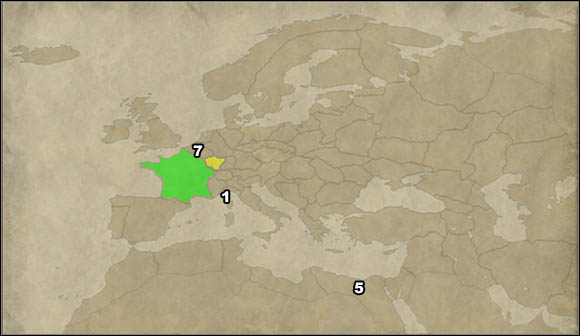
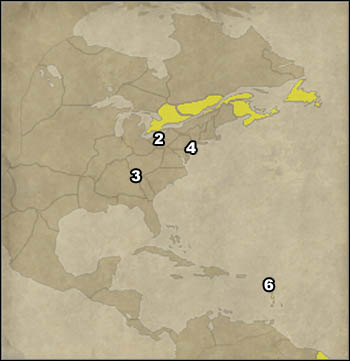
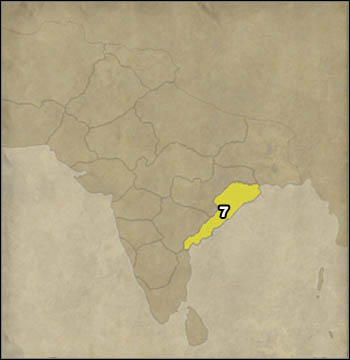
1. You have one army and one fleet on the south. Take them to Corsica and start war with Genoa. After you will conquer the island defeat Genoa and send their troops (supported with 1 or 2 regiments of Rgiments trangeres) to the Savoy.
2. At the same time build some better infrastructure in Quebec and Montreal. Start to train Colonial Line Infantry and some Indian Musketeers. Try to conquer a whole Iroquois Confederation land with them.
3. After Iroquois attack Cherokees. There is not many of them so you would be able to defeat them very quickly. If you have a possibility you can transport here some army from Genoa, Savoy or Wrttemberg. When you defeat Cherokees, Louisiana should join you. It will grant you some money from taxes. It id a very nice region - people are very happy and satisfied. You do not have to keep any army there. Anyone shouldn't attack you here too.
4. Look how many troops Britons have at the east cost of North America. It will be easy to conquer their regions for the army that have defeated Indians earlier. Take all of their provinces and then propose peace treaty. They should accept it.
5. When you will have all British regions in the North America then you should take care of the lands that are very important in this campaign. You do not need to have many troops in America - you should better start to organize some army in Europe. Prepare your troops and send them (by ships - but beware of beberian sailors) to Egypt. When you will have the Cairo then try to sign a peace treaty with the Ottoman Empire (negotiate it). If they won't accept it, destroy their fleets on the Mediterranean Sea or conquer Jerusalem.
6. Leeward Islands are in the pirates hands. It should be easy to you to defeat them. Send there 6 or 7 regiments of line infantry. Note that, after the war pirates will try to revenge. They will attack your trade ships so prepare a strong fleet to cope with them.
7. Move your troops from Cairo to India (your opponents will have a strong army there so try to reinforce your regiments in France). Conquer Orissa and then prepare to enter Karnatik (you can try to take Calcutta if you have a while).It is good to train here some Colonial Infantry - it will better than line troops from Europe or North America.
8. Try to take Flanders in a very peaceful and diplomatic way (the is no sense in attacking your ally - Spain). You can give them Newfoundland, Windward islands and some unnecessary provinces from India. You can add some interesting technology too.
After defeating Iroquois and Cherokees, Louisiana should join you. It is a very valuable province because you will receive loads of money from there. In addition, you don't need to keep there any troops- people are so happy that they won't cause any problems in the future.
Spain will propose to exchange some territories with you. You can agree if you will be able to give away Flanders for any piece of land. It is also possible that Marat Confederation will want to make the same proposition. It is a good idea - it will be very important to have some areas near India to start the invasion.
Try to trade with as many countries as you can (sometimes you will have to pay a lot of money to set the route). Send Indiamans to the east and west cost of Africa - you gain a lot of money there. Moreover, when you will conquer Corsica you can try to send few corsair ship to the Aegean Sea.
Everything will be great if you will have another king that can destroy everything in diplomacy. Soon you will have many conflicts will your neighbors - sometimes peace can be signed at once, but sometimes you will have to use your army. As Spain you will have areas in Europe (in the west Europe) and America (islands mostly). You will start with few trade partners, one strong ally (France) and patronage in New Spain.

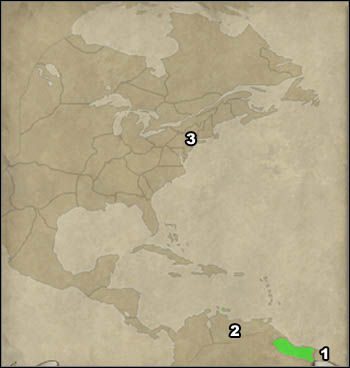
1. First of all you should carry to defend your lands. Reinforce Florida with 4 to 6 regiments of line infantry. If you want to sign a peace treaty with Cherokees you can try to invade Georgia and then ask for peace. Immediately try to invent Plug Bayonet.
2. It is very possible that Louisiana will attack you. After signing a peace treaty with Cherokees you can try to fight against France in Lower Louisiana. This conflict can end in two ways: you will take this territory or Louisiana will be incorporated to France (this is your ally so the conflict will automatically end).
3. It is possible that Naples will be attacked by the Italians from the north Apennines. Send there your army from Spain at the beginning of the game - maybe it won't result in peace but you will stop your opponent for a while. There is also a risk that Venice will try to take Lombardy from you - fights in this area shouldn't be a problem for you.
4. Try to conquer Texas - you have many Indians to kill. But the invasion from Florida should be enough to cope with them.
5. After Texas you should send some troops to pirates lands - Trinidad and Tobago. Pirates are very easy target but you must be careful during the trip - you can find many enemy ships there.
6. In Spain train some line infantry and send them to Morocco - the fight should be very short and easy (your opponent will have many, weak soldiers there).
7. Move troops from Morocco to Portugal and conquer Lisbon - Portugal will disappear from the map and the problem with their corsairs will be over. Then, order your troops to go Flanders (you have an agreements with France - remember about it!) and... read the next paragraph.
8. Time to take Netherlands. You need two of their regions: Curacao and Netherlands. First area is good to achieve in diplomatic way, but it will be very difficult because you have a hostile relationship with Holland. From the beginning. If it won't be possible then take troops from Trinidad and Tobago, reinforce them with some militia and defeat them. Netherlands will be strongly defended but if you take your army from Portugal it won't be a problem.
9. Now it is time to conquer Austria. Vienna is the last important region in this campaign. You can try to ask Wrttemberg for the military access - you will be able to move your troops from Netherlands directly to Austria. If it won't be possible then check if you still have a treaty with Genoa. You can try to transport your soldiers by ships and then attack Austria (plunder Venice too if you have a while). Now attack Vienna and the go to the Croatia and other Austrian territories. Provinces that are required to victory are here. If you want you can always invade Poland, Ottoman Empire and Prussia. Your army should be the most powerful at this moment.
10. If you don't have enough territories then attack Bahamas and Jamaica. Army from Curacao should be enough to conquer them.
If you will be attacked by Louisiana do not call your allies. It will destroy your treaty with France which is important when you will have to move your troops through this country.
If you will conquer Georgia then Great Britain will make you proposal to take this land from you. It is not a goo proposition. When you will have a war with Netherlands then Great Britain will ally with your enemy so you don't want to have them as your neighbors. It is good to border with Thirteen Colonies, they won't be a part in this conflict for 99%.
It is hard to set any trade routes because of the king. Build some major fisheries instead of trade ports.
Trade in trade basins makes no sense. At the beginning you have to conquer new regions and transport your troops. Later are places will be taken by other countries.
Tragedy. Ottoman Empire is in a very bad condition. Moreover you have many enemies - Russia, Georgia, Persia, Morocco and Venice - these are your potentials opponents. In addition you will have some religious disturbances. At the beginning try to develop your technology and infrastructure. You will need some good soldiers too. Luckily, you will be able to gain some gold from your provinces: Crimean Khanate and Barberia.
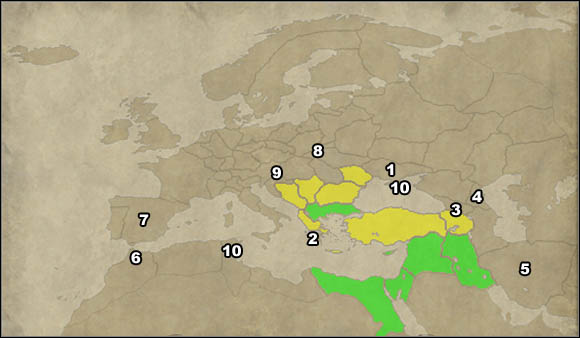
1. Beginning is very tough. Secure Crimean Khanate - send there some soldiers from Moldavia and deploy them on the... bridge near Bakczisaray. As a matter of fact Russians will not attack you for the moment. When they will come, pull back your army and return to the bridge once again. You can do this maneuver couple of times. Crimean Khanate will have some time to build some strong army.

2. Act very quickly. Train some Azzars and Bashi-bazouks in Greece. You can send there few regiments of Isarelys from Istanbul. If you will have something about 12 regiments then you can try to conquer Venice Patras. You must do it quickly, before your opponent will develop his army.
3. The next opponent - Georgia. When this country will declare war to you then you can send troops from Mesopotamia to defeat them. Try to create numerous army in Armenia (very weak troops - but it is a must) with troops from Baghdad. They try to conquer Georgia.
4. Then support your army and take Chechen and Dagestan. Dagestan can declare war to you at this moment but it is not important. This opponent is similar to Georgia - you will defeat it with easy. At the same time you can build your army on Peloponnese, in Patras.
5. Take your army from Chechen and Dagestan and lead them to Persia. Start from Azerbaijan and then go to India through Persia and Afghanistan. This will be simple because conquered people will be Muslims. You will not have any religious disturbances. Try to take all regions in from Persia.
6. Send army from Patras to Morocco (on ships). It is possible that Morocco will conquer some Berberian territories. It is good because as a matter of fact you will be able to take more areas from them.
7. Now it is time for Europe. Modernize your army from Morocco (build some Nizam-I Cedit Infantry) and attack Iberian Peninsula. Fight without good troops may be very difficult because they have very strong line infantry. If you will recruit some Nizam-I Cedit Infantry the battles will be much easier. Conquer Gibraltar, Portugal and Spain.
8. The next target - Republic of Poland. You must modernize your army to attack them. First of all buy some news units, develop your technology. No matter what - Galicia, Podole and Poland must be defeated. You will probably have a good infrastructure in Istanbul - train your soldier there and send them north. It is good to take some imams with you (to return the population).
9. After Poland attack Hungary and Austria. After these fights try to do something with Venice and Croatia.
10. If you need more lands then conquer your patronages and Malta. You can finish with Spain if you want too.
Try to have very good relations with Poland and Austria at the beginning. War with these two countries can be a tragedy for you. You will fight with them when you will be more developed.
At the beginning of the game ask every country about trade routes. Many of them will accept your proposition. It will cost you a lot of money but you will not regret that.
When you will start a war with Venice try to join your two fleets and reinforce them with 3 or 5 additional brigades. They might be useful to eliminate enemy corsair from Venice and Morocco.
Invent European Doctrine as fast as possible. As a matter of fact very good line infantry, light infantry and shooters with a very good shooting range will become available for you.
You will start with two regions, two trade partners and the hostile Mongols empire in the north. In this case you have to collect your military units and begin to invade the peninsula. The Marat Confederation has big revenues from trading with Europe and your interest is to run this business as long as you can.

1.The first thing is to defeat Majsur and Goa. Automatically you will destroy one of your trading partner, but do not worry about it. The same thing is with Portugal - taking their colony in India will protect you from them. The big problem are Portuguese privateers blocking trade routes. You can try defeat them, but it would take you a lot of time.
2.After invasion in south India you can prepare to fight against Mongols. Collect army step by step and take their territories. Do not hurry with this - your enemies are Muslims, so you need to keep your units in the new regions to avoid a religious conflict. Destroy their mosques and build your temples speed up the conversion of unbelievers.
3.After defeating Mongols move closer to the Europe. You have to start the war with Persia. Here, similar to the previous war, do not hurry with your conquest. You have to assimilate people to be sure that you will have no unpleasant surprises later. The road to Europe is simple and rather narrow, so the conquest is a matter of one, strong army. If, after defeating Persia, you still don't have enough regions, attack Ottoman Empire or Russia. It is possible that you will have to go as far as to the Black Sea.
4.Ceylon is occupied by the Dutch (one of your trading partner). At the beginning it is better leave them in peace, because it will allow trade with the Europeans with no problems. In a later stage of the game, when you will find that land is more important for you than money, you can drive out the Dutch from the island.
The issue of diplomacy in the case of the Marat Confederation is quite simple. After the expulsion of Portugals from India try to conclude a peace with them, to prevent danger from their privateers.
All the countries located near your lands are your potential enemies (especially Mongols), so its quite simple: after conquering the whole India, some countries will want you to buy Indian provinces from you, but because they are required to victory, it is better to refuse.
Important issue in the case of Marats. The main recipient of your goods is Europe, so try to build a lot of trading ports to conclude as many trade agreements as you can. Do not hesitate to spend your money on gifts - religious differences may interfere with your business.
The problem may be in privateers blocking your trading routes (at least to the moment when the land transport will become possible). It is hard to eliminate this threat, because it is located near Europe and Africa. It is a good idea to allow Europeans to resolve this problem (at least at the beginning of the game - later, when your country will be more powerful, you can do it by yourself).
The Netherlands is the only country that begins with territories in all three theaters of operations. You won't have too many lands so try to make a living from the colonial trading. Note that your neighbors in America (France and New Spain) have very weak garrisons there.
Great Britain and Austria are your friends. You have also two strong opponents: Spain and France.
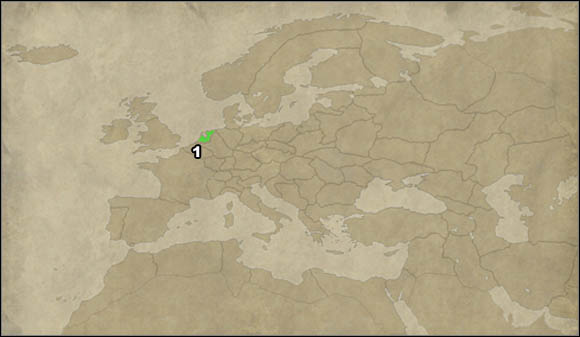

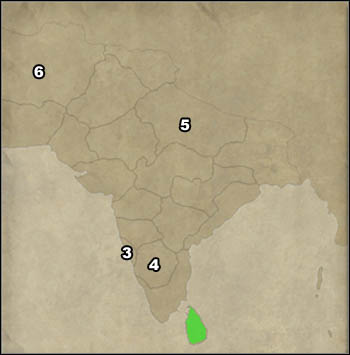
1. At the beginning try to attack Flanders in Europe and French Guiana in South America. If you will conquer them in the same turn then France and Spain won't be able to react quickly enough. You have to attack from Dutch Guiana and Netherlands. These countries can of course attack your fleet so try to make a peace with France (you can even send them some money - you will no need to fight will them later).
2. The other thing is with Spain. You will to continue your war against them by attacking New Andalusia. On Curacao train some Colonial Line Infantry, on French Guiana - Colonial Militia. With this army invade Andalusia. After this battle there should be no problems with peace with Spain and New Spain.
3. Now you must move your troops from Andalusia to New York (there should be no problem with this - you have a military access with Great Britain). At the same time you have to do the same thing in India (near Goa) - you will need a very powerful army there so be prepared. You can use some troops from Flanders, invest in technology too. If you will decide that you are prepared then conquer New York and Goa. You can try to take Pennsylvania too. They try to sign peace treaties. Great Britain should agree at once.
4. Now it is time to conquer the rest of the India. If Majsur still exists then I advise you start with it. In 95% of all cases it will be in the state of war with Marats so chose a moment of attack wisely (the best option is to attack them at the end of their war). Send many VOC Infantry units there and improve them to win these battles.
5. Now try to take Hindustan. Take every province with three, big land armies. Try to remember not to attack too quickly - you will need some time to return conquered population to your religion.
6. If still do not have enough regions the I advise you to attack Persia. It is the best strategy to attack with the same speed as with Marats and Mongols. Give yourself some time to return your people.
When the war between Austria and Prussia will start then support Austria. As a matter of fact you will be able to send your corsair troop to the Prussian trade routes (it is near your capital city). Prussia shouldn't attack you.
In Ceylon build some trade ships (the best option is to construct some Indiamans) and them east to the islands. Any other country will do the same thing, pirates are less active there too. Of course you have to set trade routes with all European countries.
After conquering Flanders keep there 4 or five regiments to be sure that France will not attack you.
When fighting in India try to be patient. Move very slowly to return the people. Keep your army in all cities and build some new churches to stabilize the situation.
You have very little land, the two trading partners and many regions to develop. You have to unite the land. Due to the small number of ports, you will have a few customers on other continents. However, this does not change the fact that Prussia can make a living from taxes. Note, that you will start with relatively strong army.
Pay attention to the national religion. Protestant Prussia may have big problems with conquered Catholic regions. Immediately begin to construct new churches and start to recruit priests.
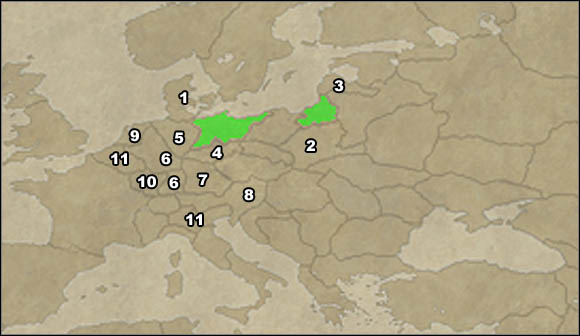
1. First, Denmark. Train some line infantry in Brandenburg and use ships to join it with troops from Krolewiec. These forces can conquer Copenhagen with easy. Immediately after the fight seek alliance with Denmark. They should accept it immediately, especially since the north of the country is engaged in war with Sweden.
2. Probably there will be a conflict between Austria and Poland. This will be a good time to cut Poland from the Baltic Sea. Reinforce your army in Copenhagen and take it by the ship to Krolewiec. Make an invasion on West Prussia from here. Now it will be a simple way to Warsaw. It would be good to conquer rest of Poland - you will get some provinces required to successfully complete the campaign.
3. If Courland will attack you during the war with Poland, try to sign peace with Poles and attack Courland. After all return to war with Poland
4. Saxony next. Without protector (Poland) they are very weak. If you have developed army, then you should have no problems in the Battle of Dresden.
5. There is a chance that in the meantime, Hanover will lose his powerful ally - United Kingdom. Without any support from the British, Hanover will be defenseless.
6. For the next attack I would propose Westphalia. It is connected with the alliance with Wrttemberg. Conquer if you can. Wrttemberg has a nice protector - Austria - but if they declare war to you, the Austrians will not take their side.
7. Here you must to fight with Austria (you have to conquer Bavaria and it is in alliance with Austria).
8. Now, you can go to Austria. This is a Catholic country, so do not scale with conquers, give yourself some time to convert the population to Protestantism. The best is to take as many regions from the as you can.
9. At the same time Netherlands will join the conflict. Conquering their lands in Europe is the idea at least worth of consideration.
10. After your conquests in Europe, the vast majority of countries will hate you. Therefore, it will be difficult to get Alsace-Lorraine only by diplomatic talks. It is already one of the last regions to gain, it is worth to risk conflict with the France
11. If you still do not have enough lands - attack Venice, as well as Spanish lands - Flanders and Lombardy.
After conquering Copenhagen and an aggression on Poland, try to make peace with Russia. As a result, the threat will disappear from the East and it will be possible to concentrate troops in the west.
At the beginning you have will the possibility to sign some agreements with some countries. Use this opportunity.
Prussia is a country which is not very good to trade at the coast of Africa, Brazil, etc. Try to set some trade routes with European countries.
Do not build learning centers. Most of the German regions has its own facilities. As a result of conquests you can gain a lot of universities where you can invent some new technologies.
Lots of enemies around, and you have a few trade routes and a single port. Sweden, Dagestan and Georgia are hostile to you, you have a war with Crimean Khanate Ottoman Empire and only two allies Denmark and Republic of Poland. Fortunately, Russia is able to cope with most of the opponents, using weak units. To conquer Sweden and Ottoman Empire advanced military infrastructure will be needed.
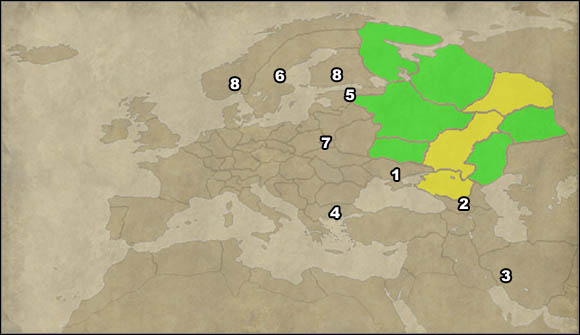
1. Collect some troops (train some Cossacks in Kiev) and conquer Crimean Khanate. Do it quickly, before the Muslims will strengthen their army.
2. At the same time, start to build army in south area of the country to defend yourself against Georgia and Dagestan. When you will defeat Crimea and you will find that you can attack the next enemy, invade Chechnya-Dagestan and Georgia.
3. Move to the south. Defeat Armenia, Mesopotamia and Persia by taking their capital. It would be useful to conquer the whole countries. Remember, you need regions.
4. After the fight against Persia move to the west, to Turkey. Try to conquer all provinces in Asia, and then focus on the city of Istanbul and other Balkan countries. This campaign against the Turks will take some time, but it should be easy, because you have the line infantry. Please remember about converting your people to Orthodoxy.
5. Time for Sweden. Train some army in Moscow and reinforce them with experienced troops from Balkans. Conquer Ingra, as well as Estonia and Livonia.
6. Transport some troops by ships to Sweden and conquer Stockholm.
7. Invade Republic of Poland, using the troops from Balkans. Your country should be strong enough to move to Poland, Lithuania and Belarus.
8. If you do not have enough regions then attack Sweden, Finland and Norway.
Sweden will attack Denmark instantly. I suggest not to join this war. You will lose an ally but you will have a peace on the south.
Russia do not have many trade routes, so it's important to secure the Crimea and Sevastopol port from the Turkish fleet. With this, trade with Western countries will be possible. Invasion on Ottoman Empire will grant you Mesopotamia - you will be able to trade with many more countries.
You begin with a country that has no ports. Although you have access to the sea, but there is a very long way to the first shipyard. Russia in the east is a very good ally and it is better not to destroy this relation at the beginning. In the West you have two opponents - Prussia and Austria. North and south: these areas are dominated by the Turks and Swedes. Both nations hates you, war with them can begin at any time.
Courland and Saxony are your patronages. You also have an ally in the west - Denmark. At the beginning of the game it is nor very important.
Poland is a relatively weak country, if compared to the western countries. As a matter of fact you must ensure that everything - development of ideology, military (including the navy) and economy - is in a very good condition. Do not worry about Berbery,
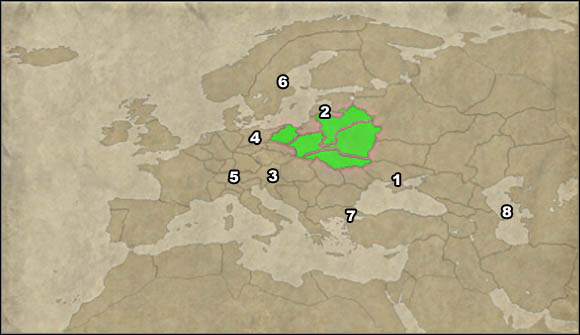
1. Take Crimean Khanate (do not call Russians for help). Keep in mind that the attack will mean that you will start a conflict with the Ottoman Empire. If you decided to invade Crimean Khanate, then be ready to make a peace very quickly. If you do not want to have a problem with the Turks, go immediately to the next paragraph.
2. Gather a very strong army in the north and declare war to Courland. The fight will be hard, but it is worth it because later you can be able to build there one more port. Swedes are to strong to fight with them now.
3. One of your goals in this campaign is to conquer Vienna. Collect some of your forces in the western part of the country. Protect your training center of Krakow, and then declare war to Austria and invade Wroclaw. From there, go to Prague and Vienna. From Vienna you can move to Croatia.
4. From Prague you can invade your patronage - Saxony. After Dresden, the way to the Prussian city of Berlin will be clear. During the fight with Austria you will surely be able to develop your country so well that the war with Prussia will be possible. Take Krolewiec too.
5. In the west atmosphere will be rather tense. Many countries will be very happy with your new territorial conquests. There is a big risk that Venice, Wrttemberg or Bavaria will attack you. You must defend yourself and you must realize that these countries are rather strong.
6. During the fights on the west you will be able to build some ports on the Baltic Sea. Reinforcement Courland with a large a group of soldiers, and then attack Sweden. You can fight on the land for Riga, St. Petersburg, and Abo, and at the same time you can to try send some army by ships to Stockholm. As Denmark for help.
7. The last major objective is to conquer Istanbul. Because you need to collect 40 provinces, I suggest to go to war with them on the land. Moldova, Serbia and Bosnia will be poorly protected, and soon they will fall into your hands. Collect enough troops to take Rumelia.
8. In order to get the required 40 provinces, you can continue to fight the Ottoman Empire. Then take Georgia, Persia, and Russia (only if you find that it is a militarily weak country). All provinces near the Caspian Sea should fall into your hands.
Prussia can ask you for the Western Prussia, in exchange for East Prussia. It is a good option, because in the city of Krolewiec is very rich.
After taking some lands in the south (Croatia) Ottoman Empire will want this area in exchange for technology. If you will find that the improvements proposed by the Turks will help you in development, a decision is clear. Under no circumstances do not give them Galicia and Podole!
Try to sign trade agreements with all your neighbors with whom you do not have a war. Colonial Trade makes no sense, although build some trade ports. Thanks to them, you will get additional business partners, such as Marats. Some distant countries are not interested in your territorial expansion in Europe and Asia - immediately sign agreements with them.
It might seem that at the beginning the situation is rather bad because the Sweden is hated by all of its neighbors. It is not a problem because you can quickly create a good and large army.
Swedes do not have allies, but they do not need them. Trade is difficult at the beginning of the game because of the low number of trade ports. This is not a big problem, because in few rounds, you can conquer rich cities such as Copenhagen, Berlin or Krolewiec.
Note that the Swedes have a very numerous cavalry. In some regiments you will find even a 100 horsemen.
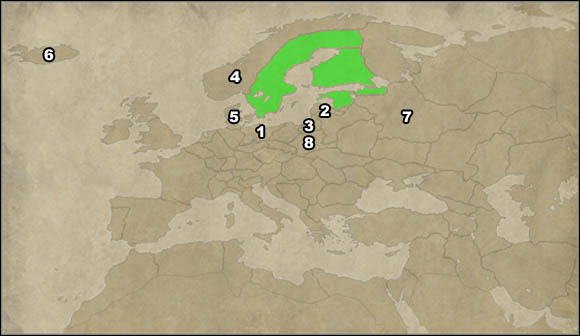
1. When Prussia will start a war with Austria, then prepare an attack on Brandenburg. Berlin is a very profitable city and Prussia have no allies. After the fight you will not border with them, so they shouldn't be a problem. Prepare quite a large army to keep civilian population in peace.
2. If Courland will declare war to you, build military infrastructure and training centers in St. Petersburg (line infantry). Join the with the army from Ingra. With 15-20 regiments you will take Courland without an effort.
3. With Courland and lot of troops in the region you can try to attack East Prussia. You have conflict with Prussia anyway, and Krolewiec is undoubtedly very useful for you.
4. Start to train some army in Stockholm. There is a big risk that Denmark will send a few troops to your lands, so you must be prepared. When you will achieve a leadership in Scandinavia, take care of Norway.
5. Time for Denmark. There is a big risk that the enemy ships will unable you to reach Copenhagen by land. You have to invest some money in fleet.
6. As a part of your territorial expansion I propose to take Iceland. This move will finish Denmark for good and you will have one more region.
7. If Poland or Russia won't attack you, you must attack them. My proposition is to take care of Russia first - thus there is no risk that Saxony will join the conflict. Fights will take place in the whole Eastern Europe, so I propose to strengthen your southern borders (5 regiments of line infantry in each province should be enough) and create two large armies. The first of them in St. Petersburg (to attack Russia and Moscow).
8. The second army should be created in Berlin or Krolewiec. Take the whole Poland (starting with Western Prussia, and ending with Galicia and Podole). When you will conquer the Republic of Poland, go to Russia (start from the Crimea for example).
Diplomacy is a very simple thing in the case of Sweden. Before you will start a war with Poland, they will offer you some lands for Prussia and Brandenburg. As the Poles do not have much to offer, I suggest to ignore their proposition.
Be sure to attack Russia first and then Poland. If you will do it in another way, Saxony can join the conflict. You do not need to have so many enemies.
You can try some colonial trading but I suggest to develop only few ports to exchange goods with Marats and some European countries.
Do not hurry with Russian and Polish conquests. The major thing is their religion - population consists of Catholics and Orthodox. You need some time to convert people to Protestantism.
You have a lot of allies in Europe, protectorate in North America, quite good fleet and beautiful perspective. Do you want more? Thirteen Colonies to join the United Kingdom. To do this, it will be necessary to conquer New France and Cherokees.
British campaign ends successfully when they conquer regions scattered all over the world. Make sure that you have the possibility of transporting troops by sea. Try also (especially in North America) to build some good training centers. You have to worry about this from the first turn.
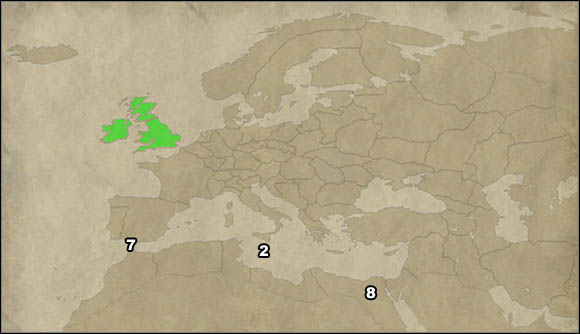
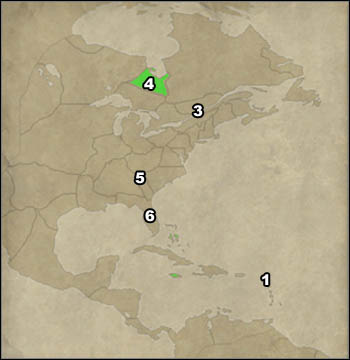
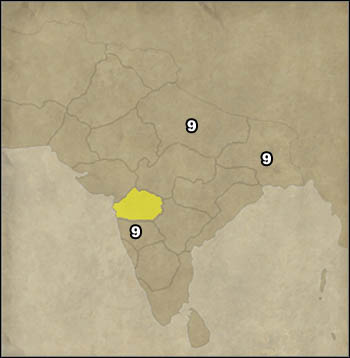
1. Start with Leeward Islands. Even a small army (6 line infantry units from Jamaica) is enough to conquer the province. Make sure that the fleet will be able to take your soldiers - gather your vessels and buy two brigs.
2. At the same time, start to train army in Great Britain. Send them to Malta. 10-15 units will be enough.
3. When you will stabilize the situation on the Leeward Islands, train some more troops in Jamaica. You'll get quite a big army, which will be able to conquer French New France. I suggest to take Acadia, Upper Canada and Newfoundland too.
4. When Huron Confederation will declare war to you, train some Hessian infantry to defend the Rupert lands. You may try to take their land.
5. Reinforce your army from the north and go to Georgia. Start war with Cherokees. Try to conquer the whole country, because then all American colonies will want to join you.
6. There is a chance that Florida will be occupied by Cherokees. The case is simple - take this land from them. If, however, that the land will remain in Spanish hands, it will be necessary to start a war with Spain (take your troops from Malta).
7. In the case of war with Spain send your troops from Malta to Gibraltar. After the conquest of Florida try to sign a peace with Spain.
8. Egypt. Once again use troops from Malta. One major should be enough, especially since the Ottoman Empire, is rather defenseless.
9. Last objectives are in India. Prepare your fleet and collect some army from North America (reinforced with some fresh units). Generally, you need three provinces - Bidzapur, Bengal and Hindustan. The creation of two strong armies that are ready to attack in two places at once is a very good idea. Do not hurry with the invasion, which must also be taken together with several priests to return the population.
At the time when Austria will attack France, it is good to declare war to France.
United Kingdom has the perfect conditions to trade at the coast of Africa, Brazil, etc., but in my opinion it does not make any sense. You will be able to set many trade routes at the beginning of the game. With only this you will get a small fortune in a short period of time.
You have Ruppert lands on the north of America. Send a priest from there to New France. As a matter of fact you will avoid some religious disturbances.
U.S. campaign begins with the creation of Jamestown. At the beginning you need to fight with the local population. Command your men to shoot the Indians. Once they will come to close order them fight in close combat. Send John Smith troops to aid them.
When the Indian chief will come, defeat him or fear him. The of his people will loose their willingness to fight.
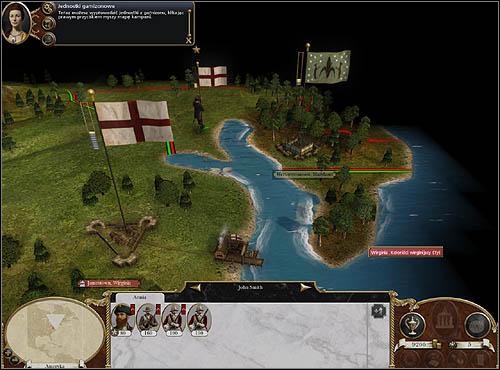
It does not matter whether you win or lose. After the battle, campaign map will be launched. Start to train some army. The best option is to recruit settlers from Jamestown - although the statistics are lower than the colonial militia, but you will have up to 160 men in one regiment.
In addition, you have to complete missions that country from the Old World will order you to do. Build port, buildings, plantations and strengthen Jamestown.
<br>With at least 4 or 5 infantry regiments attack nearby Indian village, Werowocomoco.

After you will conquer it the next region on the north will be unlocked.
<br>Another goal is to take Shackamaxon. Do not stop to train armies. Collect as much soldiers as you can (20 regiments) and start the fight. Do not worry about the time - you are restricted only with the settlers number.
<br>In the woods near Shackamaxon you can encounter enemy troops. With a large army they will not be a problem.
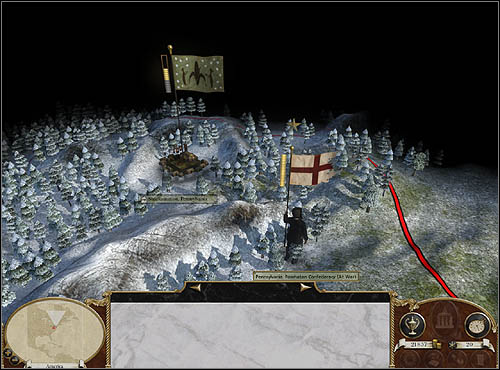
Start with the first contract and then sign an alliance with Cherokees (you can try to propose military access too). They will agree for sure. Make sure you have the trade agreement.
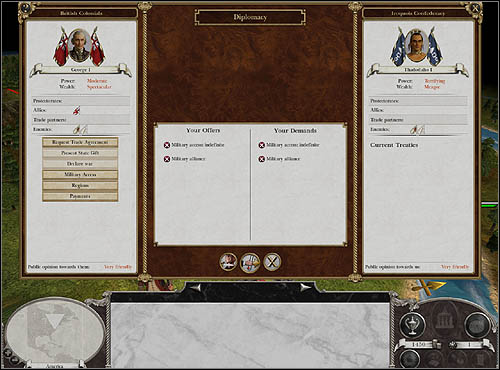
Build some farms. Join your forces and move them to the fort in the north. Wait a few rounds until you will get some more money. As before, time does not play any role here. With the money, build administrative buildings in Williamsburg and shipyard on the coast.
Go near Fort Duquesne. You will receive some money when you will conquer it. Besieged them as long as possible. French will come out and then you can start to fight.
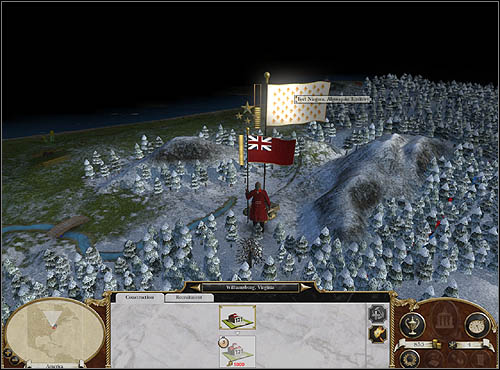
Reinforce your troops after the fight. Develop administration in the city of Williamsburg. When the reinforcements will arrive, you can go north to the Fort of Niagara. The strategy will be similar to the fight near Fort Duquesne.
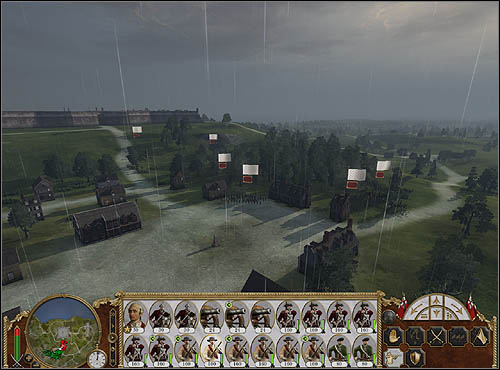
Another goal is to conquer Louisbourg. You will need a small fleet. With shipyard, begin the production of brigs (2-3).
Some French troops may be somewhere here. Use your team from Fort Niagara to destroy them. Do not send a whole army against them - you need to keep some forces to secure your land. In the meantime, develop your shipyard. When it will reach its maximum level, produce 1 or 2 fifth grade ships.
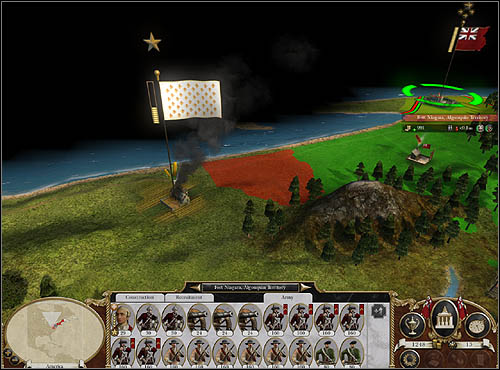
When the situation at Fort Niagara will be secured, move most of your army (about 15 regiments) to Williamsburg (notice that there is another French fort near Niagara - train some militia and Indians).
With 4 or 5 vessels (brigs mixed with the fifth grade ships), transport army from Williamsburg to Louisbourg. You meet a few opponents - take their vessels by the boarding operation to gain some new units (or more money, depending on what you want to do with the ships).
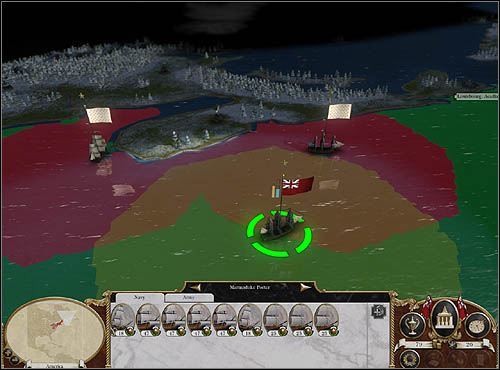
Louisbourg is defended by several French regiments. Your soldiers are experienced, so victory should be on your side.
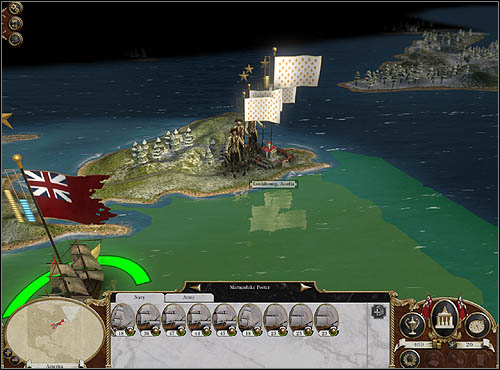
After the fight strengthen your army. If you do not have enough money, capture nearby ships and lift up the taxes.
The next goals are Quebec and Montreal. Use your boats to clean the river that leads to the village. You can block French trade routes if you want. By the way you will examine how many regiments they have in towns and forts. Troops from Louisbourg must stay where they are, as in Niagara, the situation among the local population need to normalize. You may have to face the French soldiers scattered in this area.
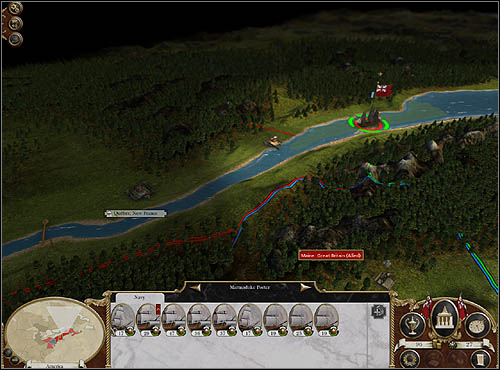
Leave some three regiments of cheap infantry in Louisbourg. Move your main army to Quebec. Nearby fort is very well defended. With well-trained soldiers you can handle it, but losses will be great. You can also attack with the strongest army - reinforce it with few infantry regiments.
After the fight reinforce your forces and attack Montreal. Quebec can cause problems without no garrison inside. To avoid the outbreak of rebellion, release the region from taxes. Money shouldn't be a problem now. In addition, this part of the war for independence will soon be completed, so the money won't a big problem. As before, besieged them as long as possible. You will defeat them with easy.
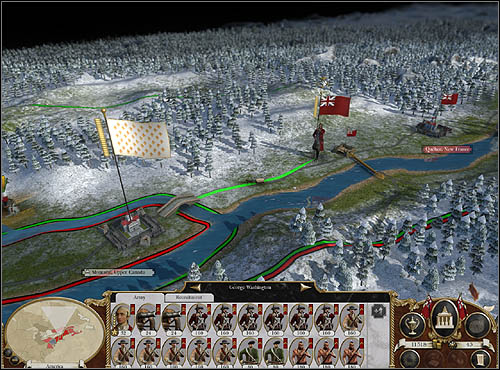
We are starting with the battle of Boston. On the north move two regiments to fight against the British. Eliminate artillery with provincial cavalry (two regiments).

In the central part of the battlefield deploy four infantry regiments. First eliminate nearby enemy artillery, and then fight with the British. Oder all your cannons to fire at the enemy infantry.

On the south move two militia regiments to the forest - shoot British and they will be forced to retreat. Do not enter the building with infantry. Probably soon they will defeat their opponents. Then you can move them to the center of the battlefield.
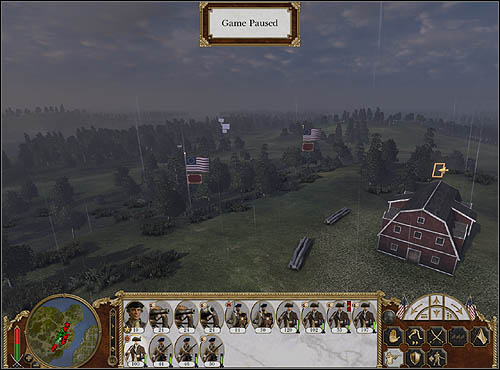
When the enemy general will appear, try to kill him - Britons to fight won't be able to fight anymore.
You start with one region, the Confederation of New England, and you have to unite the entire east coast of North America. No one does not want to have any real diplomatic relations with you - France is not interested in ally, Spain and the Netherlands do not want any trade agreement. You have few units, which must be used wisely.
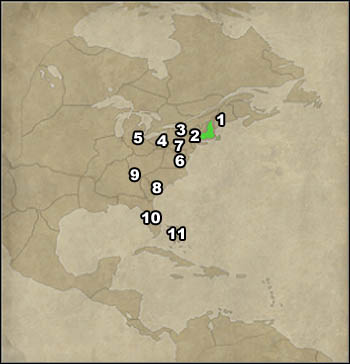
1. The first step should be to eliminate the risk from the garrison in Falmouth, to the north-east of your country. Try to develop Boston and you will be able to train line infantry there. With this type of units (make sure you're over-represented, the army is not yet sufficiently experienced to risk ratio of 1:1) attack British in the region of Maine. This is an important step not only because it eliminates the risk of the enemy attack, but conquering Falmouth will result in training center in Brunswick. Make sure that during the trip to Falmouth, Boston is protected. Keep few militia units in this area.
2. The second step should be to conquer New York. Please send an artillery to the battle, a few units of weak cavalry, and two regiment of dragoons. Do not hurry with the attack, you need time to regenerate after the Falmouth. Conquer of Albany City will give you access to the port. What's more there is a chance that Netherlands and Spain will now become your business partners.
3. If you will clear the New York with the Albany as a capital city, then go west - to the Cherokees land with the city of Cayuga. Conquering of this region may cause a conflict with local Iroquois Indians.
4. Niagara can be a strongly defended city. Collect a large and strong army (18 line infantry units with the greatest experience, 1 artillery regiment, and 1 general) to defeat Indians in this area. After the fight begin to train a strong army in Boston and Albany.
5. Finish Iroquois by conquering Detroit, Michigan. A strong army from Niagara must deal in this fight. It is good to take the city as soon as possible. With the extermination of Iroquois, Cherokees will declare war to you.
6. You can also send your troops from Niagara to Annapolis. You should not encounter strong resistance there.
7. An attack on Philadelphia is a big fight against the British garrison there, use the power of the combined armies from Annapolis and Boston-Albany. Philadelphia is very valuable, not only because of that it is a goal of the campaign, but also because it is the highly developed city.
8. If you are able to conquer Philadelphia, take next regions (Williamsburg, Charleston, Savannah).
9. Once you will reach the Savannah and Georgia, move your troops to Cherokees cities of Tellico and Chicas. It is good to defeat the very quickly (as with the Iroquois).
10. After a fight with Indians try to attack Florida. This positions are strongly defended, but you can deal with this problem - most of British troops are scattered all over the area. Contrary to yours.
11. You should have some fleet now - invade Nassau on Bahamas.
At the beginning France is your only possible ally. They probably will not want to talk with you about the alliance. You need to get some land to be respected in the world. Diplomatic talks will be later, do not think about them at the beginning. When you will conquer 4-5 lands check if they didn't change their mind.
There is a risk (or opportunity) that Indians will declare war to you. First Iroquois then Cherokees, etc.
To be able to think about the centers of production rise up the taxes. When you will conquer 2-3 new regions Spain and Netherlands will want to talk with you about the agreement.
In every Indian city you will find some buildings, but they are not useful. Please destroy it and build yours.
The beginning is a little better than before. You have an ally - France. It is no so important unfortunately. Indeed, one of the goals of the campaign is to conquer some French territories in the West, and that means that you will need to break the alliance. You also need to get the regions on the south and north (that means war with all your neighbors). To be able to provide yourself a suitable revenues you have to start to exchange goods with Europe and some colonies.

1. Tellico and Chicas should be your first targets. This nation (Cherokees) has no allies, so no one will say nothing when you make an attack. You will start with some troops of that should be enough to kill Indians.
2. There is no sense to keep peace with France. Declare war, and then conquer both Louisianas. Try to do this, however, after sending your Indiamans to Brazil and other part of the world - France can be great threat on the seas. When you will take the French territories in North America, try to sign a peace treaty.
3. Florida is needed to successfully complete the campaign. You will take it without any major problems. Conflict with Spain will not result in very dangerous land battles, they are very strong on the sea.
4. Mexico and New Mexico are your next targets. While Spanish New Mexico is not a difficult opponent, the Indian Mexico is much more tougher - enemy is numerous, but poorly trained. You have to be very quick, cause you don't have much time. After the fights try to sign peace treaty with Spain.
5. Now it will be really difficult. While attacking Iroquois or British both of these nations will start to hate you (they have alliance). In addition, Iroquois have a large army. I recommend to attack only area (which is required to victory) - in Detroit in Michigan. Attack from the upper Louisiana. You can first try to attack some territories in the south to drive enemies from Detroit. Before all of this, however, strengthen your borders. Place the additional units in Falmouth, Albany and western Pennsylvania.
6. The fight with the British may not be extremely difficult, but probably you will need some troops from other regions, such as Florida. Fort Nashwaak is not very strongly protected, so you can take it with a relatively low cost. The worse situation will be with Quebec. There is a better garrison, but your army should be strong and experienced enough to defeat it. Watch out for the British navy. Their ships can block your trade routes and you will be cut off from your money.
7. If you are still missing some provinces, send few regiments to the islands on the south. Nassau, Antigua and Port Royal are not heavily defended. You can take Martinique too. Be careful - Spain and France have a strong fleet here.
At the beginning of the game Brits will to take Maine from you in various ways, including an exchange for two provinces. One is in the north of the continent, and the other is in Europe, near Gibraltar. Personally would not recommend you accept this plan, with the Maine it will be easier for you to defeat British in the fights around Montreal and Quebec.
Spain will also want to exchange some territories with you. For the Cherokees regions they will offer you some technology inventions. This is not a good proposition too. Do not accept it.
You will start the game with one sea route. So you can sign a trade arrangement with one of the European countries such as Russia or Prussia. Unfortunately, this route can be attacked by corsairs. You can send your fleet and deal with them, but there is much simple solution - wait, Europeans will solve this problem on their own.
At the very beginning of the game build some Indiamans. Send them so Brazil and set three trade routes. It is important to start building your ships in the first turn.
In every Indian city you will find some buildings, but they are not useful. Please destroy it and build yours.
Beware of France and Spain - they have a very strong fleet!
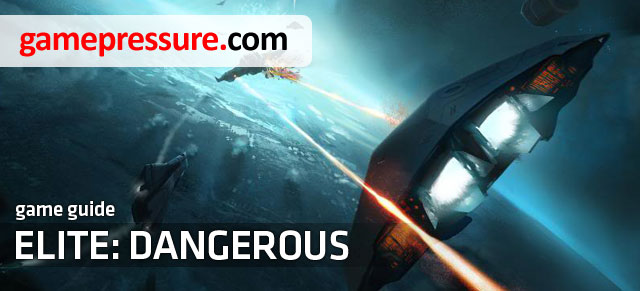

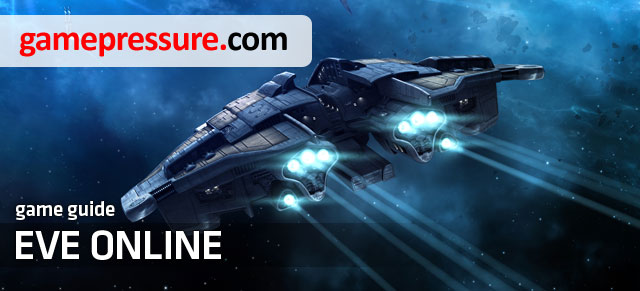

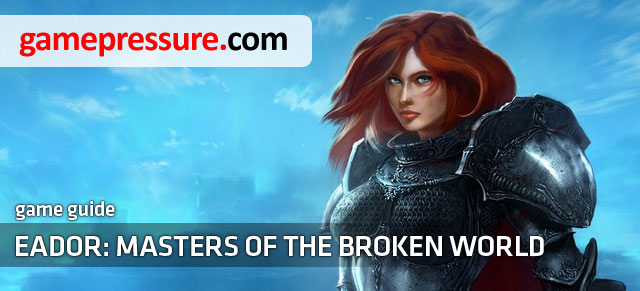 Eador: Masters of the Broken World Game Guide & Walkthrough
Eador: Masters of the Broken World Game Guide & Walkthrough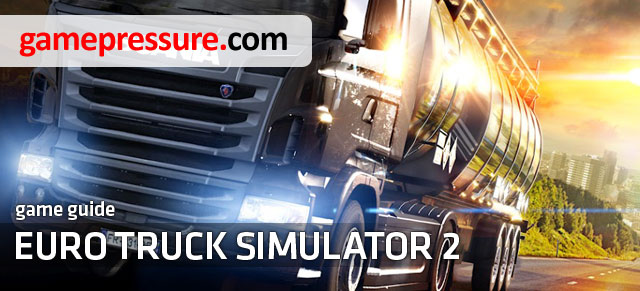 Euro Truck Simulator 2 Game Guide & Walkthrough
Euro Truck Simulator 2 Game Guide & Walkthrough EVE Online Game Guide & Walkthrough
EVE Online Game Guide & Walkthrough Endless Space Game Guide & Walkthrough
Endless Space Game Guide & Walkthrough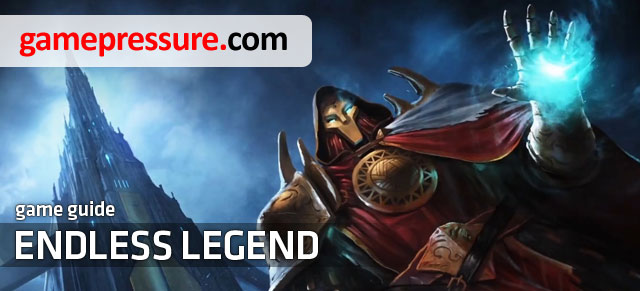 Endless Legend Game Guide & Walkthrough
Endless Legend Game Guide & Walkthrough